

This package contains base classes that are used to construct the models in Buildings.HeatTransfer.Windows.
Extends from Modelica.Icons.BasesPackage (Icon for packages containing base classes).| Name | Description |
|---|---|
| Absorbed radiation by window | |
| Model for the heat transfer coefficient at the outside of the window | |
| Model for the heat transfer coefficient at the inside of the window | |
| Model for center of glass of a window construction | |
| Model for heat convection through gas in a window assembly | |
| Model for a glass layer of a window assembly | |
| For a window with an overhang, outputs the fraction of the area that is sun exposed | |
| Lumped thermal element with variable area, transporting heat without storing it | |
| Model for convective heat balance of a layer that may or may not have a shade | |
| Model for infrared radiative heat balance of a layer that may or may not have a shade | |
| Base class for models of window shade and overhangs | |
| Converts the shading signal to be strictly bigger than 0 and smaller than 1 | |
| For a window with side fins, outputs the fraction of the area that is sun exposed | |
| Partial model for heat convection or radiation between a possibly shaded window that can be outside or inside the room | |
| Partial model for variables and data used in radiation calculation | |
| Partial model to implement overhang and side fins with weather bus connector | |
| Transmitted radiation through window | |
| Calculation radiation for window | |
| Basic parameters for window radiation calculation | |
| Radiation data of a window | |
| Free convection in vertical cavity | |
| Free convection in horizontal cavity | |
| Nusselt number for horizontal cavity, bottom surface warmer than top surface | |
| Nusselt number for horizontal cavity, bottom surface colder than top surface | |
| Get interpolated data without triggering events | |
| Collection of models that illustrate model use and test models |
 Buildings.HeatTransfer.Windows.BaseClasses.AbsorbedRadiation
Buildings.HeatTransfer.Windows.BaseClasses.AbsorbedRadiation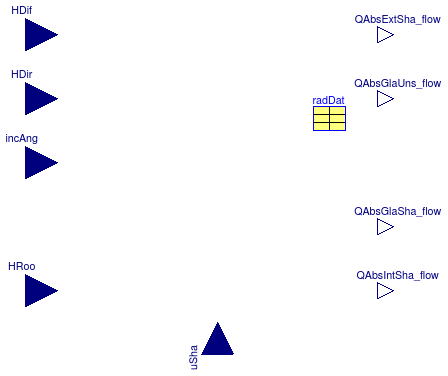
The model calculates absorbed solar radiation on the window. The calculations follow the description in Wetter (2004), Appendix A.4.3.
The absorbed radiation by exterior shades includes:
AWin*uSha*(HDir+HDif)*(1-tau-rho)
AWin*uSha*HDir*tau*rho(IncAng)*(1-tau-rho)
AWin*uSha*HDif*tau*rho(HEM)*(1-tau-rho)
The output is absRad[2, 1]
The absorbed radiation by interior shades includes:
AWin*uSha*HDir*alpha(IncAng)
AWin*uSha*HDif*alpha(HEM)
AWin*uSha*HRoo*(1-tau-rho)
The output is absRad[2, N+2]
The absorbed radiation by glass includes:
AWin*(1-uSha)*(HDif*alphaEx(HEM)+HRoo*alphaIn(HEM))
AWin*(1-uSha)*HDir*alphaEx(IncAng)
AWin*uSha*(HDif*alphaExSha(HEM)+HRoo*alphaInSha(HEM))
AWin*uSha*HDir*alphaExSha(IncAng)
The output is absRad[1, 2:N+1] = Part1 + Part2; absRad[2, 2:N+1] = Part3 + Part4
| Type | Name | Default | Description |
|---|---|---|---|
| Boolean | haveExteriorShade | Set to true if window has an exterior shade | |
| Boolean | haveInteriorShade | Set to true if window has an interior shade | |
| Area | AWin | Area of window [m2] | |
| Glass | |||
| Integer | N | Number of glass layers | |
| Length | xGla[N] | Thickness of glass [m] | |
| TransmissionCoefficient | tauGlaSol[N] | Solar transmissivity of glass [1] | |
| ReflectionCoefficient | rhoGlaSol_a[N] | Solar reflectivity of glass at surface a (facing outside) [1] | |
| ReflectionCoefficient | rhoGlaSol_b[N] | Solar reflectivity of glass at surface b (facing room-side) [1] | |
| Shade | |||
| TransmissionCoefficient | tauShaSol_a | Solar transmissivity of shade for irradiation from air-side [1] | |
| TransmissionCoefficient | tauShaSol_b | Solar transmissivity of shade for irradiation from glass-side [1] | |
| ReflectionCoefficient | rhoShaSol_a | Solar reflectivity of shade for irradiation from air-side [1] | |
| ReflectionCoefficient | rhoShaSol_b | Solar reflectivity of shade for irradiation from glass-side [1] | |
| Type | Name | Description |
|---|---|---|
| input RealInput | uSha | Control signal for shading (0: unshaded; 1: fully shaded) |
| input RealInput | HDif | Diffussive solar radiation [W/m2] |
| input RealInput | incAng | Incident angle [rad] |
| input RealInput | HDir | Direct solar radiation [W/m2] |
| input RealInput | HRoo | Diffussive radiation from room [W/m2] |
| output RealOutput | QAbsExtSha_flow | Absorbed interior and exterior radiation by exterior shading device [W] |
| output RealOutput | QAbsIntSha_flow | Absorbed interior and exterior radiation by interior shading device [W] |
| output RealOutput | QAbsGlaUns_flow[N] | Absorbed interior and exterior radiation by unshaded part of glass [W] |
| output RealOutput | QAbsGlaSha_flow[N] | Absorbed interior and exterior radiation by shaded part of glass [W] |
block AbsorbedRadiation "Absorbed radiation by window" extends Buildings.HeatTransfer.Windows.BaseClasses.PartialRadiation;Modelica.Blocks.Interfaces.RealInput HRoo(quantity="RadiantEnergyFluenceRate", unit="W/m2") "Diffussive radiation from room "; Modelica.Blocks.Interfaces.RealOutput QAbsExtSha_flow(final quantity="Power", final unit="W") "Absorbed interior and exterior radiation by exterior shading device"; Modelica.Blocks.Interfaces.RealOutput QAbsIntSha_flow(final quantity="Power", final unit="W") "Absorbed interior and exterior radiation by interior shading device"; Modelica.Blocks.Interfaces.RealOutput QAbsGlaUns_flow[N](each quantity= "Power", each final unit="W") "Absorbed interior and exterior radiation by unshaded part of glass"; Modelica.Blocks.Interfaces.RealOutput QAbsGlaSha_flow[N](each quantity= "Power", each final unit="W") "Absorbed interior and exterior radiation by shaded part of glass"; output Modelica.SIunits.Power absRad[2, N + 2] "Absorbed interior and exterior radiation. (absRad[2,1]: exterior shading device, absRad[1,2 to N+1]: glass (unshaded part), absRad[2,2 to N+1]: glass (shaded part), absRad[2,N+2]: interior shading device)"; protected Integer k=1; Real x; final parameter Integer NDIR=radDat.NDIR; final parameter Integer HEM=radDat.HEM; constant Integer NoShade=1; constant Integer Shade=2; constant Integer Interior=1; constant Integer Exterior=2; final parameter Real coeAbsEx[2, radDat.N, radDat.HEM + 2](fixed=false); final parameter Real coeRefExtPan1[radDat.HEM + 2](fixed=false) "Reflectivity of pane 1"; final parameter Real coeAbsIn[2, radDat.N](fixed=false); final parameter Real coeAbsDevExtIrrIntSha[radDat.HEM + 2](fixed=false) "Absorptivity of interior shading device for exterior radiation"; final parameter Real coeAbsDevExtIrrExtSha=1 - radDat.traRefShaDev[1, 1] - radDat.traRefShaDev[2, 1] "Absorptivity of exterior shading device for exterior radiation"; final parameter Real coeAbsDevIntIrrIntSha=radDat.devAbsIntIrrIntSha "Absorptivity of interior shading device for interior radiation"; final parameter Real coeAbsDevIntIrrExtSha=1 - radDat.winTraRefIntIrrExtSha[1] - radDat.winTraRefIntIrrExtSha[2] "Absorptivity of exterior shading device for interior radiation"; Real tmpNoSha; Real tmpSha; Real incAng2; initial algorithm //************************************************************** // Assign coefficients. // Data dimension changes from Orginal ([1 : HEM]) to New ([2 : HEM+1]) // with 2 dummy variable for interpolation. //************************************************************** // Glass for i in 1:N loop for j in 1:HEM loop // Properties for glass without shading coeAbsEx[NoShade, i, j + 1] := radDat.absExtIrrNoSha[i, j]; coeAbsIn[NoShade, i] := radDat.absIntIrrNoSha[i]; // Properties for glass with shading if haveInteriorShade then coeAbsEx[Shade, i, j + 1] := radDat.absExtIrrIntSha[i, j]; coeAbsIn[Shade, i] := radDat.absIntIrrIntSha[i]; elseif haveExteriorShade then coeAbsEx[Shade, i, j + 1] := radDat.absExtIrrExtSha[i, j]; coeAbsIn[Shade, i] := radDat.absIntIrrExtSha[i]; else // No Shade coeAbsEx[Shade, i, j + 1] := 0.0; coeAbsIn[Shade, i] := 0.0; end if; end for; // Dummy variables at 1 and HEM+2 for k in NoShade:Shade loop coeAbsEx[k, i, 1] := coeAbsEx[k, i, 2]; coeAbsEx[k, i, HEM + 2] := coeAbsEx[k, i, HEM + 1]; end for; end for; // Glass Pane 1: Reflectivity for j in 1:HEM loop coeRefExtPan1[j + 1] := radDat.traRef[2, 1, N, j]; end for; // Interior shades for j in 1:HEM loop coeAbsDevExtIrrIntSha[j + 1] := radDat.devAbsExtIrrIntShaDev[j]; end for; // Dummy variables at 1 and HEM+2 coeRefExtPan1[1] := coeRefExtPan1[2]; coeRefExtPan1[HEM + 2] := coeRefExtPan1[HEM + 1]; coeAbsDevExtIrrIntSha[1] := coeAbsDevExtIrrIntSha[2]; coeAbsDevExtIrrIntSha[HEM + 2] := coeAbsDevExtIrrIntSha[HEM + 1]; algorithm absRad[NoShade, 1] := 0.0; absRad[NoShade, N + 2] := 0.0; absRad[Shade, 1] := 0.0; absRad[Shade, N + 2] := 0.0; //************************************************************** // Glass: absorbed diffusive radiation from exterior and interior sources //************************************************************** for i in 1:N loop absRad[NoShade, i + 1] := AWin*(1 - uSha_internal)*(HDif*coeAbsEx[NoShade, i, HEM + 1] + HRoo*coeAbsIn[NoShade, i]); absRad[Shade, i + 1] := AWin*uSha_internal*(HDif*coeAbsEx[Shade, i, HEM + 1] + HRoo*coeAbsIn[Shade, i]); end for; //************************************************************** // Shading device: absorbed radiation from exterior source //************************************************************** // Exterior Shading Device: // direct radiation: 1. direct absorption; // diffusive radiation: 1. direct absorption 2. absorption from back reflection if haveExteriorShade then absRad[Shade, 1] := AWin*uSha_internal*coeAbsDevExtIrrExtSha*(HDif + HDir + HDif*radDat.traRefShaDev[1, 1]*radDat.traRef[2, 1, N, HEM]); // Interior Shading Device: diffusive radiation from both interior and exterior elseif haveInteriorShade then absRad[Shade, N + 2] := AWin*uSha_internal*(HDif*radDat.devAbsExtIrrIntShaDev[ HEM] + HRoo*coeAbsDevIntIrrIntSha); end if; //************************************************************** // Glass, Device: add absorbed direct radiation from exterior sources //************************************************************** // Use min() instead of if() to avoid event incAng2 := min(incAng, 0.5*Modelica.Constants.pi); x := 2*(NDIR - 1)*abs(incAng2)/Modelica.Constants.pi "x=(index-1)*incAng/(0.5pi), 0<=x<=NDIR"; x := x + 2; for i in 1:N loop // Glass without shading: Add absorbed direct radiation tmpNoSha := Buildings.HeatTransfer.Windows.BaseClasses.smoothInterpolation({ coeAbsEx[NoShade, i, k] for k in 1:(HEM + 2)}, x); absRad[NoShade, i + 1] := absRad[NoShade, i + 1] + AWin*HDir*(1 - uSha_internal)*tmpNoSha; // Glass with shading: add absorbed direct radiation tmpSha := Buildings.HeatTransfer.Windows.BaseClasses.smoothInterpolation({ coeAbsEx[Shade, i, k] for k in 1:(HEM + 2)}, x); absRad[Shade, i + 1] := absRad[Shade, i + 1] + AWin*HDir*uSha_internal* tmpSha; end for; // Interior shading device: add absorbed direct radiation if haveInteriorShade then tmpSha := Buildings.HeatTransfer.Windows.BaseClasses.smoothInterpolation({ coeAbsDevExtIrrIntSha[k] for k in 1:(HEM + 2)}, x); absRad[Shade, N + 2] := absRad[Shade, N + 2] + AWin*HDir*uSha_internal* tmpSha; end if; // Exterior shading device: add absorbed reflection of direct radiation from exterior source if haveExteriorShade then tmpNoSha := Buildings.HeatTransfer.Windows.BaseClasses.smoothInterpolation({ coeRefExtPan1[k] for k in 1:(HEM + 2)}, x); absRad[Shade, 1] := absRad[Shade, 1] + AWin*HDir*uSha_internal* coeAbsDevExtIrrExtSha*tmpNoSha; end if; // Assign quantities to output connectors QAbsExtSha_flow := absRad[2, 1]; QAbsIntSha_flow := absRad[2, N + 2]; QAbsGlaUns_flow[:] := absRad[1, 2:N + 1]; QAbsGlaSha_flow[:] := absRad[2, 2:N + 1];end AbsorbedRadiation;
 Buildings.HeatTransfer.Windows.BaseClasses.ExteriorConvectionCoefficient
Buildings.HeatTransfer.Windows.BaseClasses.ExteriorConvectionCoefficient
h = 4+4 v
where v is the wind speed in m/s and h is the convective heat transfer coefficient in W/(m2*K).
| Type | Name | Default | Description |
|---|---|---|---|
| Area | A | Heat transfer area [m2] |
| Type | Name | Description |
|---|---|---|
| output RealOutput | GCon | Convective thermal conductance [W/K] |
| input RealInput | v | Wind speed [m/s] |
model ExteriorConvectionCoefficient "Model for the heat transfer coefficient at the outside of the window" extends Modelica.Blocks.Interfaces.BlockIcon; parameter Modelica.SIunits.Area A "Heat transfer area";Modelica.Blocks.Interfaces.RealOutput GCon(unit="W/K") "Convective thermal conductance"; Modelica.Blocks.Interfaces.RealInput v(unit="m/s") "Wind speed"; equation GCon = A*(4+4*Buildings.Utilities.Math.Functions.smoothMax(v, -v, 0.1));end ExteriorConvectionCoefficient;
 Buildings.HeatTransfer.Windows.BaseClasses.InteriorConvectionCoefficient
Buildings.HeatTransfer.Windows.BaseClasses.InteriorConvectionCoefficient
h = 4 W ⁄ (m2 K).
TARCOG 2006: Carli, Inc., TARCOG: Mathematical models for calculation of thermal performance of glazing systems with our without shading devices, Technical Report, Oct. 17, 2006.
Extends from Modelica.Blocks.Interfaces.BlockIcon (Basic graphical layout of input/output block).
| Type | Name | Default | Description |
|---|---|---|---|
| Area | A | Heat transfer area [m2] |
| Type | Name | Description |
|---|---|---|
| output RealOutput | GCon | Convective thermal conductance [W/K] |
model InteriorConvectionCoefficient "Model for the heat transfer coefficient at the inside of the window" extends Modelica.Blocks.Interfaces.BlockIcon; parameter Modelica.SIunits.Area A "Heat transfer area";Modelica.Blocks.Interfaces.RealOutput GCon(unit="W/K") "Convective thermal conductance"; equation GCon = 4*A;end InteriorConvectionCoefficient;
 Buildings.HeatTransfer.Windows.BaseClasses.CenterOfGlass
Buildings.HeatTransfer.Windows.BaseClasses.CenterOfGlass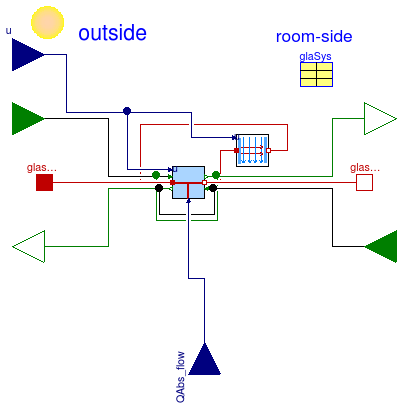
glaSys.
The model contains these main component models:
extSha and intSha
for the heat balance of the shade, modeled using
Buildings.HeatTransfer.Windows.BaseClasses.Shade.
glass for the heat conduction and the
infrared radiative heat balance of the glass layers.
There can be an arbitrary number of glass layers, which are all modeled using
instances of
Buildings.HeatTransfer.Windows.BaseClasses.GlassLayer.
gas for the gas layers. There is one model of a
gas layer between each window panes. The gas layers are modeled using instances of
Buildings.HeatTransfer.Windows.BaseClasses.GasConvection.
| Type | Name | Default | Description |
|---|---|---|---|
| Area | A | Surface area [m2] | |
| Angle | til | Surface tilt (only 90 degrees=vertical is implemented) [rad] | |
| Generic | glaSys | Glazing system | |
| Boolean | linearize | false | Set to true to linearize emissive power |
| Type | Name | Description |
|---|---|---|
| input RadiosityInflow | JIn_a | Incoming radiosity at surface a [W] |
| input RadiosityInflow | JIn_b | Incoming radiosity at surface b [W] |
| output RadiosityOutflow | JOut_a | Outgoing radiosity at surface a [W] |
| output RadiosityOutflow | JOut_b | Outgoing radiosity at surface b [W] |
| input RealInput | u | Input connector, used to scale the surface area to take into account an operable shading device |
| HeatPort_a | glass_a | Heat port connected to the outside facing surface of the glass |
| HeatPort_b | glass_b | Heat port connected to the room-facing surface of the glass |
| input RealInput | QAbs_flow[size(glass, 1)] | Solar radiation absorbed by glass [W] |
model CenterOfGlass
"Model for center of glass of a window construction"
extends Buildings.HeatTransfer.Radiosity.BaseClasses.RadiosityTwoSurfaces;
parameter Modelica.SIunits.Area A "Heat transfer area";
parameter Modelica.SIunits.Angle til(displayUnit="deg")
"Surface tilt (only 90 degrees=vertical is implemented)";
parameter Buildings.HeatTransfer.Data.GlazingSystems.Generic glaSys
"Glazing system";
Modelica.Blocks.Interfaces.RealInput u
"Input connector, used to scale the surface area to take into account an operable shading device";
Buildings.HeatTransfer.Windows.BaseClasses.GlassLayer[glaSys.nLay] glass(
each final A=A,
final x=glaSys.glass.x,
final k=glaSys.glass.k,
final absIR_a=glaSys.glass.absIR_a,
final absIR_b=glaSys.glass.absIR_b,
final tauIR=glaSys.glass.tauIR,
each final linearize=linearize) "Window glass layer";
Buildings.HeatTransfer.Windows.BaseClasses.GasConvection gas[glaSys.nLay-1](
each final A=A,
final gas=glaSys.gas,
each final til=til,
each linearize=linearize) "Window gas layer";
// Note that the interior shade is flipped horizontally. Hence, surfaces a and b are exchanged,
// i.e., surface a faces the room, while surface b faces the window
Modelica.Thermal.HeatTransfer.Interfaces.HeatPort_a glass_a
"Heat port connected to the outside facing surface of the glass";
Modelica.Thermal.HeatTransfer.Interfaces.HeatPort_b glass_b
"Heat port connected to the room-facing surface of the glass";
parameter Boolean linearize=false "Set to true to linearize emissive power";
Modelica.Blocks.Interfaces.RealInput QAbs_flow[size(glass, 1)](each unit="W", each
quantity = "Power")
"Solar radiation absorbed by glass";
equation
for i in 1:glaSys.nLay-1 loop
connect(glass[i].port_b, gas[i].port_a);
connect(gas[i].port_b, glass[i+1].port_a);
connect(glass[i].JOut_b, glass[i+1].JIn_a);
connect(glass[i].JIn_b, glass[i+1].JOut_a);
connect(u, gas[i].u);
end for;
for i in 1:glaSys.nLay loop
connect(u, glass[i].u);
end for;
connect(glass_b, glass[glaSys.nLay].port_b);
connect(glass_a, glass[1].port_a);
connect(JIn_a, glass[1].JIn_a);
connect(glass[1].JOut_a, JOut_a);
connect(glass[glaSys.nLay].JOut_b, JOut_b);
connect(JIn_b, glass[glaSys.nLay].JIn_b);
connect(glass.QAbs_flow, QAbs_flow);
end CenterOfGlass;
 Buildings.HeatTransfer.Windows.BaseClasses.GasConvection
Buildings.HeatTransfer.Windows.BaseClasses.GasConvection
To use this model, set the parameter til
to a value defined in
Buildings.HeatTransfer.Types.Tilt.
If the parameter linearize is set to true,
then all equations are linearized.
| Type | Name | Default | Description |
|---|---|---|---|
| Generic | gas | Thermophysical properties of gas fill | |
| Area | A | Heat transfer area [m2] | |
| Area | h | sqrt(A) | Height of window [m2] |
| Angle | til | Surface tilt (only 0, 90 and 180 degrees are implemented) [rad] | |
| Boolean | linearize | false | Set to true to linearize emissive power |
| Temperature | T0 | 293.15 | Temperature used to compute thermophysical properties [K] |
| Type | Name | Description |
|---|---|---|
| input RealInput | u | Input connector, used to scale the surface area to take into account an operable shading device |
model GasConvection
"Model for heat convection through gas in a window assembly"
extends Modelica.Thermal.HeatTransfer.Interfaces.Element1D(
port_a(T(start=293.15)),
port_b(T(start=293.15)));
extends Buildings.BaseClasses.BaseIcon;
parameter Buildings.HeatTransfer.Data.Gases.Generic gas
"Thermophysical properties of gas fill";
parameter Modelica.SIunits.Area A "Heat transfer area";
parameter Modelica.SIunits.Area h(min=0) = sqrt(A) "Height of window";
parameter Modelica.SIunits.Angle til(displayUnit="deg")
"Surface tilt (only 0, 90 and 180 degrees are implemented)";
parameter Boolean linearize=false "Set to true to linearize emissive power";
Modelica.Blocks.Interfaces.RealInput u
"Input connector, used to scale the surface area to take into account an operable shading device";
parameter Modelica.SIunits.Temperature T0 = 293.15
"Temperature used to compute thermophysical properties";
Modelica.SIunits.CoefficientOfHeatTransfer hCon(min=0, start=3)
"Convective heat transfer coefficient";
Modelica.SIunits.HeatFlux q_flow "Convective heat flux";
Real Nu(min=0) "Nusselt number";
Real Ra(min=0) "Rayleigh number";
protected
Modelica.SIunits.Temperature T_a
"Temperature used for thermophysical properties at port_a";
Modelica.SIunits.Temperature T_b
"Temperature used for thermophysical properties at port_b";
Modelica.SIunits.Temperature T_m
"Temperature used for thermophysical properties";
Real deltaNu(min=0.01) = 0.1
"Small value for Nusselt number, used for smoothing";
Real deltaRa(min=0.01) = 100
"Small value for Rayleigh number, used for smoothing";
final parameter Real cosTil=Modelica.Math.cos(til) "Cosine of window tilt";
final parameter Real sinTil=Modelica.Math.sin(til) "Sine of window tilt";
final parameter Boolean isVertical = abs(cosTil) < 10E-10
"Flag, true if the window is in a wall";
final parameter Boolean isHorizontal = abs(sinTil) < 10E-10
"Flag, true if the window is horizontal";
// Quantities that are only used in linearized model
parameter Modelica.SIunits.CoefficientOfHeatTransfer hCon0(fixed=false)
"Convective heat transfer coefficient";
parameter Real Nu0(fixed=false, min=0) "Nusselt number";
parameter Real Ra0(fixed=false, min=0) "Rayleigh number";
parameter Boolean homotopyInitialization = true "= true, use homotopy method";
initial equation
assert(isVertical or isHorizontal, "Only vertical and horizontal windows are implemented.");
initial equation
// Computations that are used in the linearized model only
Ra0 = Buildings.HeatTransfer.Convection.Functions.HeatFlux.rayleigh(
x=gas.x,
rho=Buildings.HeatTransfer.Data.Gases.density(gas, T0),
c_p=Buildings.HeatTransfer.Data.Gases.specificHeatCapacity(gas, T0),
mu=Buildings.HeatTransfer.Data.Gases.dynamicViscosity(gas, T0),
k=Buildings.HeatTransfer.Data.Gases.thermalConductivity(gas, T0),
T_a=T0-5,
T_b=T0+5,
Ra_min=100);
(Nu0, hCon0) = Buildings.HeatTransfer.Windows.BaseClasses.convectionVerticalCavity(
gas=gas, Ra=Ra0, T_m=T0, dT=10, h=h, deltaNu=deltaNu, deltaRa=deltaRa);
equation
T_a = port_a.T;
T_b = port_b.T;
T_m = (port_a.T+port_b.T)/2;
if linearize then
Ra=Ra0;
Nu=Nu0;
hCon=hCon0;
q_flow = hCon0 * dT;
else
Ra = Buildings.HeatTransfer.Convection.Functions.HeatFlux.rayleigh(
x=gas.x,
rho=Buildings.HeatTransfer.Data.Gases.density(gas, T_m),
c_p=Buildings.HeatTransfer.Data.Gases.specificHeatCapacity(gas, T_m),
mu=Buildings.HeatTransfer.Data.Gases.dynamicViscosity(gas, T_m),
k=Buildings.HeatTransfer.Data.Gases.thermalConductivity(gas, T_m),
T_a=T_a,
T_b=T_b,
Ra_min=100);
if isVertical then
(Nu, hCon, q_flow) = Buildings.HeatTransfer.Windows.BaseClasses.convectionVerticalCavity(
gas=gas, Ra=Ra, T_m=T_m, dT=dT, h=h, deltaNu=deltaNu, deltaRa=deltaRa);
elseif isHorizontal then
(Nu, hCon, q_flow) = Buildings.HeatTransfer.Windows.BaseClasses.convectionHorizontalCavity(
gas=gas, Ra=Ra, T_m=T_m, dT=dT, til=til, sinTil=sinTil, cosTil=cosTil,
h=h, deltaNu=deltaNu, deltaRa=deltaRa);
else
Nu = 0;
hCon=0;
q_flow=0;
end if; // isVertical or isHorizontal
end if; // linearize
if homotopyInitialization then
Q_flow = u*A*homotopy(actual=q_flow,
simplified=hCon0*dT);
else
Q_flow = u*A*q_flow;
end if;
end GasConvection;
 Buildings.HeatTransfer.Windows.BaseClasses.GlassLayer
Buildings.HeatTransfer.Windows.BaseClasses.GlassLayer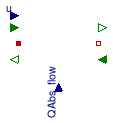
QAbs_flow
needs to be connected to the solar radiation that is absorbed
by the glass pane.
The model computes the heat conduction between the two glass surfaces.
The heat flow QAbs_flow is added at the center of the glass.
The model also computes the infrared radiative heat balance using an instance
of the model
Buildings.HeatTransfer.Radiosity.WindowPane.
| Type | Name | Default | Description |
|---|---|---|---|
| Area | A | Surface area [m2] | |
| Emissivity | absIR_a | Infrared absorptivity of surface a [1] | |
| Emissivity | absIR_b | Infrared absorptivity of surface b [1] | |
| ReflectionCoefficient | rhoIR_a | 1 - absIR_a - tauIR | Infrared reflectivity of surface a [1] |
| ReflectionCoefficient | rhoIR_b | 1 - absIR_b - tauIR | Infrared reflectivity of surface b [1] |
| TransmissionCoefficient | tauIR | Infrared transmissivity of glass pane [1] | |
| Boolean | linearize | false | Set to true to linearize emissive power |
| Temperature | T0 | 293.15 | Temperature used to linearize radiative heat transfer [K] |
| Length | x | Material thickness [m] | |
| ThermalConductivity | k | Thermal conductivity [W/(m.K)] | |
| Advanced | |||
| Boolean | homotopyInitialization | true | = true, use homotopy method |
| Type | Name | Description |
|---|---|---|
| input RadiosityInflow | JIn_a | Incoming radiosity at surface a [W] |
| input RadiosityInflow | JIn_b | Incoming radiosity at surface b [W] |
| output RadiosityOutflow | JOut_a | Outgoing radiosity at surface a [W] |
| output RadiosityOutflow | JOut_b | Outgoing radiosity at surface b [W] |
| input RealInput | u | Input connector, used to scale the surface area to take into account an operable shading device |
| HeatPort_a | port_a | Heat port at surface a |
| HeatPort_b | port_b | Heat port at surface b |
| input RealInput | QAbs_flow | Solar radiation absorbed by glass [W] |
model GlassLayer "Model for a glass layer of a window assembly"
extends Buildings.HeatTransfer.Radiosity.BaseClasses.RadiosityTwoSurfaces;
extends Buildings.HeatTransfer.Radiosity.BaseClasses.ParametersTwoSurfaces(
final rhoIR_a=1-absIR_a-tauIR,
final rhoIR_b=1-absIR_b-tauIR);
parameter Modelica.SIunits.Length x "Material thickness";
parameter Modelica.SIunits.ThermalConductivity k "Thermal conductivity";
parameter Modelica.SIunits.Area A "Heat transfer area";
parameter Modelica.SIunits.Emissivity absIR_a
"Infrared absorptivity of surface a (usually room-facing surface)";
parameter Modelica.SIunits.Emissivity absIR_b
"Infrared absorptivity of surface b (usually outside-facing surface)";
parameter Modelica.SIunits.Emissivity tauIR "Infrared transmittance of glass";
Modelica.Blocks.Interfaces.RealInput u
"Input connector, used to scale the surface area to take into account an operable shading device";
Modelica.Thermal.HeatTransfer.Interfaces.HeatPort_a port_a(T(start=293.15, nominal=293.15))
"Heat port at surface a";
Modelica.Thermal.HeatTransfer.Interfaces.HeatPort_b port_b(T(start=293.15, nominal=293.15))
"Heat port at surface b";
Modelica.Blocks.Interfaces.RealInput QAbs_flow(unit="W", quantity="Power")
"Solar radiation absorbed by glass";
parameter Boolean linearize=false "Set to true to linearize emissive power";
parameter Boolean homotopyInitialization = true "= true, use homotopy method";
protected
Real T4_a(min=1E8, unit="K4", start=293.15^4, nominal=1E10)
"4th power of temperature at surface a";
Real T4_b(min=1E8, unit="K4", start=293.15^4, nominal=1E10)
"4th power of temperature at surface b";
Modelica.SIunits.HeatFlowRate E_a(min=0, nominal=1E2)
"Emissive power of surface a";
Modelica.SIunits.HeatFlowRate E_b(min=0, nominal=1E2)
"Emissive power of surface b";
final parameter Modelica.SIunits.ThermalResistance R = x/2/k/A
"Thermal resistance from surface of glass to center of glass";
equation
// Heat balance of surface node
// These equations are from Window 6 Technical report, (2.1-14) to (2.1-17)
0 = port_a.Q_flow + port_b.Q_flow + QAbs_flow + JIn_a + JIn_b - JOut_a - JOut_b;
u * (port_b.T-port_a.T) = 2*R * (-port_a.Q_flow-QAbs_flow/2-JIn_a+JOut_a);
// Radiosity balance
if linearize then
T4_a = 4*T03*port_a.T - 3*T04;
T4_b = 4*T03*port_b.T - 3*T04;
else
if homotopyInitialization then
T4_a = homotopy(actual=port_a.T^4, simplified=4*T03*port_a.T - 3*T04);
T4_b = homotopy(actual=port_b.T^4, simplified=4*T03*port_b.T - 3*T04);
else
T4_a = port_a.T^4;
T4_b = port_b.T^4;
end if;
end if;
// Emissive power
E_a = u * A * absIR_a * Modelica.Constants.sigma * T4_a;
E_b = u * A * absIR_b * Modelica.Constants.sigma * T4_b;
// Radiosities that are outgoing from the surface, which are
// equal to the infrared absorptivity plus the reflected incoming
// radiosity plus the radiosity that is transmitted from the
// other surface.
JOut_a = E_a + rhoIR_a * JIn_a + tauIR * JIn_b;
JOut_b = E_b + rhoIR_b * JIn_b + tauIR * JIn_a;
end GlassLayer;
 Buildings.HeatTransfer.Windows.BaseClasses.Overhang
Buildings.HeatTransfer.Windows.BaseClasses.Overhang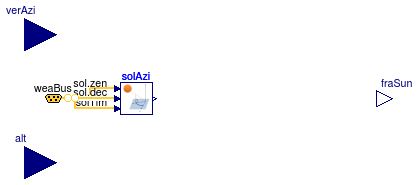
For a window with an overhang, this block outputs the fraction of the area that is exposed to the sun. This models can also be used for doors with an overhang.
Input to this block are the wall solar azimuth angle and the altitude angle of the sun. These angles can be calculated using blocks from the package Buildings.BoundaryConditions.SolarGeometry.BaseClasses.
The overhang can be asymmetrical (i.e. wR ≠ wL)
about the vertical centerline
of the window.
The overhang must completely cover the window (i.e.,
wL ≥ 0 and
wR ≥ 0).
wL and wR are measured from the left and right edge of the window.
The surface azimuth azi is as defined in
Buildings.HeatTransfer.Types.Azimuth.
The method of super position is used to calculate the window shaded area. The area below the overhang is divided as shown in the figure.
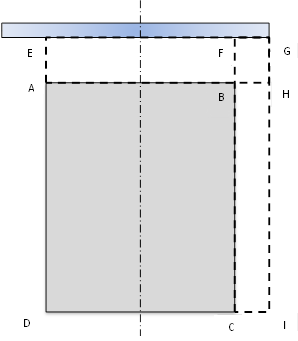
Dimensional variables used in code for the rectangle DEGI, AEGH, CFGI and BFGH are shown in the figure below:
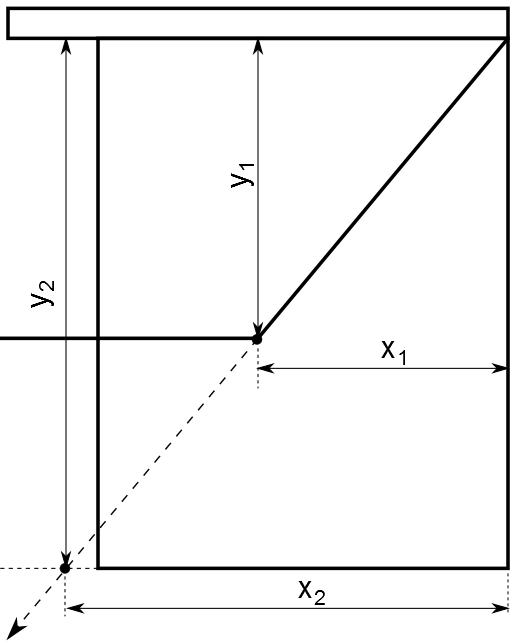
The rectangles DEGI, AEGH, CFGI and BFGH have the same geometric configuration
with respect to the overhang.
Thus, the same algorithm can be used to calculate the shaded portion in these areas.
A single equation in the for loop improves the total calculation time,
as compared to if-then-else
conditions, considering the various shapes of the shaded portions.
To find the shaded area in window ABCD, the shaded portion of AEGD and CFGI
should be subtracted from that of DEGI and BFGH.
This shaded area of the window is then divided by the total window area
to calculate the shaded fraction of the window.
| Type | Name | Default | Description |
|---|---|---|---|
| Angle | lat | Latitude [rad] | |
| Angle | azi | Surface azimuth; azi= -90 degree East; azi= 0 degree South [rad] | |
| Overhang | |||
| Length | wL | Overhang width left to the window, measured from the window corner [m] | |
| Length | wR | Overhang width right to the window, measured from the window corner [m] | |
| Length | dep | Overhang depth (measured perpendicular to the wall plane) [m] | |
| Length | gap | Distance between window upper edge and overhang lower edge [m] | |
| Window | |||
| Length | hWin | Window height [m] | |
| Length | wWin | Window width [m] | |
| Type | Name | Description |
|---|---|---|
| input RealInput | verAzi | Wall solar azimuth angle (angle between projection of sun's rays and normal to vertical surface) [rad] |
| input RealInput | alt | Altitude angle [rad] |
| output RealOutput | fraSun | Fraction of window area exposed to the sun [1] |
| Bus | weaBus |
block Overhang "For a window with an overhang, outputs the fraction of the area that is sun exposed" extends Modelica.Blocks.Interfaces.BlockIcon; extends Buildings.Rooms.BaseClasses.Overhang;Modelica.Blocks.Interfaces.RealInput verAzi(quantity="Angle", unit="rad", displayUnit="deg") "Wall solar azimuth angle (angle between projection of sun's rays and normal to vertical surface)"; Modelica.Blocks.Interfaces.RealInput alt( quantity="Angle", unit="rad", displayUnit="deg") "Altitude angle"; Modelica.Blocks.Interfaces.RealOutput fraSun(final min=0, final max=1, final unit="1") "Fraction of window area exposed to the sun"; parameter Modelica.SIunits.Angle lat "Latitude"; parameter Modelica.SIunits.Angle azi(displayUnit="deg") "Surface azimuth; azi= -90 degree East; azi= 0 degree South"; // Window dimensions parameter Modelica.SIunits.Length hWin "Window height"; parameter Modelica.SIunits.Length wWin "Window width";Buildings.BoundaryConditions.WeatherData.Bus weaBus; protected constant Modelica.SIunits.Angle delSolAzi = 0.005 "Half-width of transition interval between left and right formulation for overhang"; final parameter Modelica.SIunits.Area AWin= hWin*wWin "Window area"; parameter Modelica.SIunits.Length tmpH[4](each fixed=false) "Height rectangular sections used for superposition"; Modelica.SIunits.Length w "Either wL or wR, depending on the sun relative to the wall azimuth"; Modelica.SIunits.Length tmpW[4] "Width of rectangular sections used for superpositions"; Modelica.SIunits.Length del_L = wWin/100 "Fraction of window dimension over which min-max functions are smoothened"; Modelica.SIunits.Length x1 "Horizontal distance between window side edge and shadow corner"; Modelica.SIunits.Length x2[4] "Horizontal distance between window side edge and point where shadow line and window lower edge intersects"; Modelica.SIunits.Length y1 "Vertical distance between overhang and shadow lower edge"; Modelica.SIunits.Length y2[4] "Window height (vertical distance corresponding to x2)"; Real shdwTrnglRtio "ratio of y1 and x1"; Modelica.SIunits.Area area[4] "Shaded areas of the sections used in superposition"; Modelica.SIunits.Area shdArea "Shaded area calculated from equations"; Modelica.SIunits.Area crShdArea "Final value for shaded area"; Modelica.SIunits.Area crShdArea1 "Corrected for the sun behind the surface/wall"; Modelica.SIunits.Area crShdArea2 "Corrected for the sun below horizon";Buildings.BoundaryConditions.SolarGeometry.BaseClasses.SolarAzimuth solAzi(lat=lat) "Solar azimuth"; initial algorithm assert(wL >= 0, "Overhang must cover complete window Received overhang width on left hand side, wL = " + String(wL)); assert(wR >= 0, "Overhang must cover complete window Received overhang width on right hand side, wR = " + String(wR)); for i in 1:4 loop tmpH[i] := gap + mod((i - 1), 2)*hWin; end for; equation // if dep=0, then the equation // y1*Modelica.Math.cos(verAzi) = dep*Modelica.Math.tan(alt); // is singular. Hence, we treat this special case with an // if-then construct. // This also increases computing efficiency in // Buildings.HeatTransfer.Windows.FixedShade in case the window has no overhang. if haveOverhang then //Temporary height and widths are for the areas below the overhang //These areas are used in superposition w = Buildings.Utilities.Math.Functions.spliceFunction( pos=wL, neg=wR, x=solAzi.solAzi-azi, deltax=delSolAzi); tmpW[1] = w + wWin; tmpW[2] = w; tmpW[3] = w; tmpW[4] = w + wWin; y1*Modelica.Math.cos(verAzi) = dep*Modelica.Math.tan(alt); x1 = dep*Modelica.Math.tan(verAzi); shdwTrnglRtio*x1 = y1; for i in 1:4 loop y2[i] = tmpH[i]; x2[i]*y1 = x1*tmpH[i]; area[i] = Buildings.Utilities.Math.Functions.smoothMin( x1=y1, x2=y2[i], deltaX=del_L)*tmpW[i] - (Buildings.Utilities.Math.Functions.smoothMin( y1, tmpH[i], del_L)*Buildings.Utilities.Math.Functions.smoothMin( x1=x2[i], x2=y1, deltaX=del_L)/2) + Buildings.Utilities.Math.Functions.smoothMax( x1=shdwTrnglRtio*(Buildings.Utilities.Math.Functions.smoothMin( x1=x1, x2=x2[i], deltaX=del_L) - tmpW[i]), x2=0, deltaX=del_L)*Buildings.Utilities.Math.Functions.smoothMax( x1=(Buildings.Utilities.Math.Functions.smoothMin( x1=x1, x2=x2[i], deltaX=del_L) - tmpW[i]), x2=0, deltaX=del_L)/2; end for; shdArea = area[4] + area[3] - area[2] - area[1]; // correction case: Sun not in front of the wall crShdArea1 = Buildings.Utilities.Math.Functions.spliceFunction( pos=shdArea, neg=AWin, x=(Modelica.Constants.pi/2)-verAzi, deltax=0.01); // correction case: Sun not above horizon crShdArea2 = Buildings.Utilities.Math.Functions.spliceFunction( pos=shdArea, neg=AWin, x=alt, deltax=0.01); crShdArea=Buildings.Utilities.Math.Functions.smoothMax(x1=crShdArea1, x2=crShdArea2, deltaX=0.01); fraSun = Buildings.Utilities.Math.Functions.smoothMin( x1=Buildings.Utilities.Math.Functions.smoothMax(x1=1-crShdArea/AWin,x2=0,deltaX=0.01), x2=1.0, deltaX=0.01); else w = 0; tmpW=fill(0.0, 4); y1 = 0; x1 = 0; shdwTrnglRtio = 0; for i in 1:4 loop y2[i] = 0; x2[i] = 0; area[i] = 0; end for; shdArea = 0; crShdArea1 = 0; crShdArea2 = 0; crShdArea = 0; fraSun = 0; end if;connect(weaBus.solTim, solAzi.solTim); connect(weaBus.sol.zen, solAzi.zen); connect(weaBus.sol.dec, solAzi.decAng); end Overhang;
 Buildings.HeatTransfer.Windows.BaseClasses.ThermalConductor
Buildings.HeatTransfer.Windows.BaseClasses.ThermalConductor
This is a model for transport of heat without storing it.
It is identical to the thermal conductor from the Modelica Standard Library,
except that it adds an input signal u.
Extends from Modelica.Thermal.HeatTransfer.Interfaces.Element1D (Partial heat transfer element with two HeatPort connectors that does not store energy), Buildings.BaseClasses.BaseIconLow (Base icon with model name below the icon).
| Type | Name | Default | Description |
|---|---|---|---|
| ThermalConductance | G | Constant thermal conductance of material [W/K] |
| Type | Name | Description |
|---|---|---|
| HeatPort_a | port_a | |
| HeatPort_b | port_b | |
| input RealInput | u | Input signal for thermal conductance |
model ThermalConductor
"Lumped thermal element with variable area, transporting heat without storing it"
extends Modelica.Thermal.HeatTransfer.Interfaces.Element1D;
extends Buildings.BaseClasses.BaseIconLow;
parameter Modelica.SIunits.ThermalConductance G
"Constant thermal conductance of material";
Modelica.Blocks.Interfaces.RealInput u(min=0)
"Input signal for thermal conductance";
equation
Q_flow = u*G*dT;
end ThermalConductor;
 Buildings.HeatTransfer.Windows.BaseClasses.ShadeConvection
Buildings.HeatTransfer.Windows.BaseClasses.ShadeConvection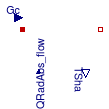
Model for the convective heat balance of a shade that is in the outside or the room-side of a window.
The convective heat balance is based on the model described by Wright (2008), which can be shown as a convective heat resistance model as follows:
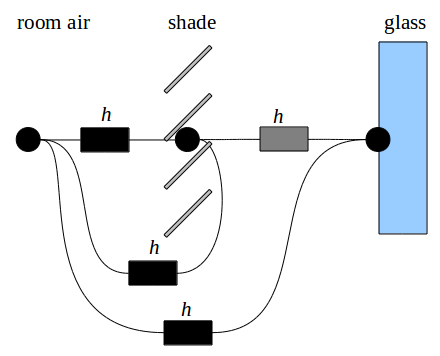
Wright (2008) reports that if the shading layer is far enough from the window, the boundary layers associated with each surface will not interfere with each other. In this case, it is reasonable to consider each surface on an individual basis by setting the convective heat transfer coefficient shown in grey to zero, and setting the black depicted convective heat transfer coefficients to h=4 W/m2 K. In the here implemented model, the grey depicted convective heat transfer coefficient is set set to h' = k h, where 0 ≤ k ≤ 1 is a parameter.
| Type | Name | Default | Description |
|---|---|---|---|
| Area | A | Heat transfer area [m2] | |
| Boolean | thisSideHasShade | Set to true if this side of the window has a shade | |
| Real | k | 1 | Coefficient used to scale convection between shade and glass |
| Type | Name | Description |
|---|---|---|
| input RealInput | Gc | Signal representing the convective thermal conductance [W/K] |
| HeatPort_a | air | Port that connects to the air (room or outside) |
| HeatPort_b | glass | Heat port that connects to shaded part of glass |
| input RealInput | QRadAbs_flow | Total net radiation that is absorbed by the shade (positive if absorbed) [W] |
| output RealOutput | TSha | Shade temperature [K] |
model ShadeConvection
"Model for convective heat balance of a layer that may or may not have a shade"
parameter Modelica.SIunits.Area A "Heat transfer area";
parameter Boolean thisSideHasShade
"Set to true if this side of the window has a shade";
parameter Real k(min=0, max=1)=1
"Coefficient used to scale convection between shade and glass";
Modelica.Blocks.Interfaces.RealInput Gc(unit="W/K")
"Signal representing the convective thermal conductance";
Modelica.Thermal.HeatTransfer.Interfaces.HeatPort_a air
"Port that connects to the air (room or outside)";
Modelica.Thermal.HeatTransfer.Interfaces.HeatPort_b glass
"Heat port that connects to shaded part of glass";
Modelica.Blocks.Interfaces.RealInput QRadAbs_flow(unit="W")
"Total net radiation that is absorbed by the shade (positive if absorbed)";
Modelica.Blocks.Interfaces.RealOutput TSha(quantity="ThermodynamicTemperature",
unit="K") "Shade temperature";
equation
if thisSideHasShade then
// Convective heat balance of shade.
// The term 2*Gc is to combine the parallel convective heat transfer resistances,
// see figure in info section.
// 2*(air.T-TSha) = k*(glass.T-TSha);
// Convective heat flow at air node
air.Q_flow = Gc*(2*(air.T-TSha) + (air.T-glass.T));
// Convective heat flow at glass node
glass.Q_flow = Gc*((glass.T-air.T)+k*(glass.T-TSha));
air.Q_flow + glass.Q_flow + QRadAbs_flow = 0;
else
air.Q_flow = Gc*(air.T-glass.T);
air.Q_flow + glass.Q_flow = 0;
TSha = (air.T+glass.T)/2;
end if;
end ShadeConvection;
 Buildings.HeatTransfer.Windows.BaseClasses.ShadeRadiation
Buildings.HeatTransfer.Windows.BaseClasses.ShadeRadiation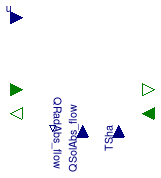
Model for the infrared radiative heat balance of a shade that is at the outside or the room-side of a window. The model also includes the absorbed solar radiation.
The input port QAbs_flow needs to be connected to the solar radiation
that is absorbed by the shade.
| Type | Name | Default | Description |
|---|---|---|---|
| Area | A | Heat transfer area [m2] | |
| Emissivity | absIR_air | Infrared absorptivity of surface that faces air [1] | |
| Emissivity | absIR_glass | Infrared absorptivity of surface that faces glass [1] | |
| TransmissionCoefficient | tauIR_air | Infrared transmissivity of shade for radiation coming from the exterior or the room [1] | |
| TransmissionCoefficient | tauIR_glass | Infrared transmissivity of shade for radiation coming from the glass [1] | |
| Boolean | thisSideHasShade | Set to true if this side of the window has a shade | |
| Boolean | linearize | false | Set to true to linearize emissive power |
| Temperature | T0 | 293.15 | Temperature used to linearize radiative heat transfer [K] |
| Advanced | |||
| Boolean | homotopyInitialization | true | = true, use homotopy method |
| Type | Name | Description |
|---|---|---|
| input RealInput | u | Input connector, used to scale the surface area to take into account an operable shading device |
| input RealInput | QSolAbs_flow | Solar radiation absorbed by shade [W] |
| input RadiosityInflow | JIn_air | Incoming radiosity at the air-side surface of the shade [W] |
| input RadiosityInflow | JIn_glass | Incoming radiosity at the glass-side surface of the shade [W] |
| output RadiosityOutflow | JOut_air | Outgoing radiosity at the air-side surface of the shade [W] |
| output RadiosityOutflow | JOut_glass | Outgoing radiosity at the glass-side surface of the shade [W] |
| output RealOutput | QRadAbs_flow | Total net radiation that is absorbed by the shade (positive if absorbed) [W] |
| input RealInput | TSha | Shade temperature [K] |
model ShadeRadiation
"Model for infrared radiative heat balance of a layer that may or may not have a shade"
parameter Modelica.SIunits.Area A "Heat transfer area";
parameter Modelica.SIunits.Emissivity absIR_air
"Infrared absorptivity of surface that faces air";
parameter Modelica.SIunits.Emissivity absIR_glass
"Infrared absorptivity of surface that faces glass";
parameter Modelica.SIunits.TransmissionCoefficient tauIR_air
"Infrared transmissivity of shade for radiation coming from the exterior or the room";
parameter Modelica.SIunits.TransmissionCoefficient tauIR_glass
"Infrared transmissivity of shade for radiation coming from the glass";
parameter Boolean thisSideHasShade
"Set to true if this side of the window has a shade";
final parameter Modelica.SIunits.ReflectionCoefficient rhoIR_air=1-absIR_air-tauIR_air
"Infrared reflectivity of surface that faces air";
final parameter Modelica.SIunits.ReflectionCoefficient rhoIR_glass=1-absIR_glass-tauIR_glass
"Infrared reflectivity of surface that faces glass";
parameter Boolean linearize = false "Set to true to linearize emissive power";
parameter Boolean homotopyInitialization = true "= true, use homotopy method";
parameter Modelica.SIunits.Temperature T0=293.15
"Temperature used to linearize radiative heat transfer";
Modelica.Blocks.Interfaces.RealInput u
"Input connector, used to scale the surface area to take into account an operable shading device";
Modelica.Blocks.Interfaces.RealInput QSolAbs_flow(unit="W", quantity="Power")
"Solar radiation absorbed by shade";
Interfaces.RadiosityInflow JIn_air(start=A*0.8*Modelica.Constants.sigma*293.15^4)
"Incoming radiosity at the air-side surface of the shade";
Interfaces.RadiosityInflow JIn_glass(start=A*0.8*Modelica.Constants.sigma*293.15^4)
"Incoming radiosity at the glass-side surface of the shade";
Interfaces.RadiosityOutflow JOut_air
"Outgoing radiosity at the air-side surface of the shade";
Interfaces.RadiosityOutflow JOut_glass
"Outgoing radiosity at the glass-side surface of the shade";
Modelica.Blocks.Interfaces.RealOutput QRadAbs_flow(unit="W")
"Total net radiation that is absorbed by the shade (positive if absorbed)";
Modelica.Blocks.Interfaces.RealInput TSha(quantity="ThermodynamicTemperature",
unit="K",
start=293.15) if
thisSideHasShade "Shade temperature";
protected
Modelica.Blocks.Interfaces.RealInput TSha_internal(quantity="ThermodynamicTemperature",
unit="K",
start=293.15) "Internal connector for shade temperature";
final parameter Real T03(min=0, final unit="K3")=T0^3
"3rd power of temperature T0";
Real T4(min=1E8, start=293.15^4, nominal=1E10, final unit="K4")
"4th power of temperature";
Modelica.SIunits.RadiantPower E_air "Emissive power of surface that faces air";
Modelica.SIunits.RadiantPower E_glass
"Emissive power of surface that faces glass";
equation
connect(TSha_internal, TSha);
if thisSideHasShade then
// Radiosities that are outgoing from the surface, which are
// equal to the infrared absorptivity plus the reflected incoming
// radiosity plus the radiosity that is transmitted from the
// other surface.
if linearize then
T4 = T03 * TSha_internal;
else
if homotopyInitialization then
T4 = homotopy(actual=(TSha_internal)^4, simplified=T03 * TSha_internal);
else
T4 = TSha_internal^4;
end if;
end if;
E_air = u * A * absIR_air * Modelica.Constants.sigma * T4;
E_glass = u * A * absIR_glass * Modelica.Constants.sigma * T4;
// Radiosity outgoing from shade towards air side and glass side
JOut_air = E_air + tauIR_glass * JIn_glass + rhoIR_air*JIn_air;
JOut_glass = E_glass + tauIR_air * JIn_air + rhoIR_glass*JIn_glass;
// Radiative heat balance of shade.
QSolAbs_flow + absIR_air*JIn_air + absIR_glass*JIn_glass
= E_air+E_glass+QRadAbs_flow;
else
QRadAbs_flow = 0;
T4 = T03 * T0;
E_air = 0;
E_glass = 0;
JOut_air = JIn_glass;
JOut_glass = JIn_air;
TSha_internal = T0;
end if;
end ShadeRadiation;
 Buildings.HeatTransfer.Windows.BaseClasses.ShadeInterface_weatherBus
Buildings.HeatTransfer.Windows.BaseClasses.ShadeInterface_weatherBus
Partial model to implement overhang and side fin model with weather bus as a connector.
Extends from Modelica.Blocks.Interfaces.BlockIcon (Basic graphical layout of input/output block).
| Type | Name | Description |
|---|---|---|
| Bus | weaBus | Weather data bus |
| input RealInput | incAng | Solar incidence angle [rad] |
| input RealInput | HDirTilUns | Direct solar irradiation on tilted, unshaded surface [W/m2] |
| output RealOutput | HDirTil | Direct solar irradiation on tilted, shaded surface [W/m2] |
| output RealOutput | fraSun | Fraction of the area that is unshaded [1] |
partial model ShadeInterface_weatherBus "Base class for models of window shade and overhangs" extends Modelica.Blocks.Interfaces.BlockIcon;Buildings.BoundaryConditions.WeatherData.Bus weaBus "Weather data bus"; Modelica.Blocks.Interfaces.RealInput incAng(quantity="Angle", unit="rad", displayUnit="rad") "Solar incidence angle"; Modelica.Blocks.Interfaces.RealInput HDirTilUns( quantity="RadiantEnergyFluenceRate", unit="W/m2") "Direct solar irradiation on tilted, unshaded surface"; Modelica.Blocks.Interfaces.RealOutput HDirTil( quantity="RadiantEnergyFluenceRate", unit="W/m2") "Direct solar irradiation on tilted, shaded surface"; Modelica.Blocks.Interfaces.RealOutput fraSun(final min=0, final max=1, final unit="1") "Fraction of the area that is unshaded"; end ShadeInterface_weatherBus;
 Buildings.HeatTransfer.Windows.BaseClasses.ShadingSignal
Buildings.HeatTransfer.Windows.BaseClasses.ShadingSignal
u
or by 1-u (if a shade is present), the heat balance can be singular
for u=0 or for u=1.
This model avoids this singularity by slightly changing the control signal.
Extends from Modelica.Blocks.Interfaces.SO (Single Output continuous control block).
| Type | Name | Default | Description |
|---|---|---|---|
| Boolean | haveShade | Set to true if a shade is present |
| Type | Name | Description |
|---|---|---|
| output RealOutput | y | Connector of Real output signal |
| input RealInput | u | Shading control signal, 0: unshaded; 1: fully shaded |
| output RealOutput | yCom | 1-u |
block ShadingSignal "Converts the shading signal to be strictly bigger than 0 and smaller than 1" extends Modelica.Blocks.Interfaces.SO; parameter Boolean haveShade "Set to true if a shade is present";Modelica.Blocks.Interfaces.RealInput u if haveShade "Shading control signal, 0: unshaded; 1: fully shaded"; Modelica.Blocks.Interfaces.RealOutput yCom "1-u"; protected constant Real y0 = 1E-6 "Smallest allowed value for y if a shade is present"; constant Real k = 1-2*y0 "Gain for shading signal"; Modelica.Blocks.Interfaces.RealInput u_in_internal "Needed to connect to conditional connector"; equation connect(u, u_in_internal); if not haveShade then u_in_internal = 0; end if; if haveShade then y = y0 + k * u_in_internal; yCom = 1-y; else y = 0; yCom = 1; end if;end ShadingSignal;
 Buildings.HeatTransfer.Windows.BaseClasses.SideFins
Buildings.HeatTransfer.Windows.BaseClasses.SideFins
For a window with side fins, this block outputs the fraction of the area that is exposed to the sun. This models can also be used for doors with side fins.
Input to this block are the wall solar azimuth angle and the altitude angle of the sun. These angles can be calculated using blocks from the package Buildings.BoundaryConditions.SolarGeometry.BaseClasses.
The model assumes that
The method of super position is used to calculate the shaded area of the window. The area besides the side fin is divided as shown in the figure below.
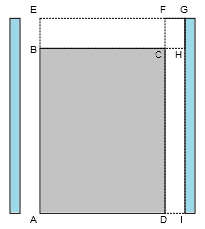
Variables used in the code for the rectangle AEGI, BEGH, DFGI and CFGH are shown in figure below.
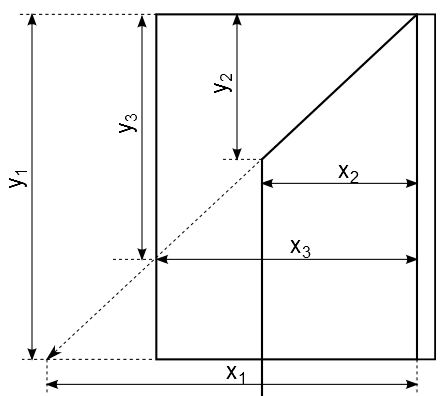
The rectangles AEGI, BEGH, DFGI and CFGH have the same geometric configuration
with respect to the side fin.
Thus, the same algorithm is used to calculate the shaded portion in these areas.
A single equation in the for loop improves the total calculation time,
as compared to if-then-else
conditions, considering the various shapes of the shaded portions.
To find the shaded area in the window ABCD, the shaded portion of
BEGH and DFGI is subtracted from AEGI and CFGH.
This shaded area of the window is then divided by the total window area
to calculate the shaded fraction of the window.
| Type | Name | Default | Description |
|---|---|---|---|
| Side fin | |||
| Length | h | Height of side fin that extends above window, measured from top of window [m] | |
| Length | dep | Side fin depth (measured perpendicular to the wall plane) [m] | |
| Length | gap | Distance between side fin and window edge [m] | |
| Window | |||
| Length | hWin | Window height [m] | |
| Length | wWin | Window width [m] | |
| Type | Name | Description |
|---|---|---|
| input RealInput | alt | Solar altitude angle (angle between sun ray and horizontal surface) [rad] |
| input RealInput | verAzi | Angle between projection of sun's rays and normal to vertical surface [rad] |
| output RealOutput | fraSun | Fraction of window area exposed to the sun [1] |
block SideFins "For a window with side fins, outputs the fraction of the area that is sun exposed" extends Modelica.Blocks.Interfaces.BlockIcon; extends Buildings.Rooms.BaseClasses.SideFins;Modelica.Blocks.Interfaces.RealInput alt(quantity="Angle", unit="rad", displayUnit="deg") "Solar altitude angle (angle between sun ray and horizontal surface)"; Modelica.Blocks.Interfaces.RealInput verAzi(quantity="Angle", unit="rad", displayUnit="deg") "Angle between projection of sun's rays and normal to vertical surface"; Modelica.Blocks.Interfaces.RealOutput fraSun(final min=0, final max=1, final unit="1") "Fraction of window area exposed to the sun"; // Window dimensions parameter Modelica.SIunits.Length hWin "Window height"; parameter Modelica.SIunits.Length wWin "Window width"; // Other calculation variables protected final parameter Modelica.SIunits.Length tmpH[4]= {h+hWin, h, h+hWin, h} "Height of rectangular sections used for superposition"; final parameter Modelica.SIunits.Length tmpW[4]= {gap + wWin,gap + wWin,gap, gap} "Width of rectangular sections used for superpositions; c1,c2 etc"; final parameter Modelica.SIunits.Length deltaL=wWin/100 "Fraction of window dimension over which min-max functions are smoothened"; final parameter Modelica.SIunits.Area AWin=hWin*wWin "Window area"; Modelica.SIunits.Length x1[4] "Horizontal distance between side fin and point where shadow line and window lower edge intersects"; Modelica.SIunits.Length x2 "Horizontal distance between side fin and shadow corner"; Modelica.SIunits.Length x3[4] "Window width"; Modelica.SIunits.Length y1[4] "Window height"; Modelica.SIunits.Length y2 "Vertical distance between window upper edge and shadow corner"; Modelica.SIunits.Length y3[4] "Vertical distance between window upper edge and point where shadow line and window side edge intersects"; Modelica.SIunits.Area area[4] "Shaded areas of the sections used in superposition"; Modelica.SIunits.Area shdArea "Shaded area"; Modelica.SIunits.Area crShdArea "Final value of shaded area"; Modelica.SIunits.Area crShdArea1 "Shaded area, corrected for the sun behind the surface/wall"; Modelica.SIunits.Area crShdArea2 "Shaded area, corrected for the sun below horizon"; Modelica.SIunits.Length minX[4]; Modelica.SIunits.Length minY[4]; Modelica.SIunits.Length minX2X3[4]; Modelica.SIunits.Length minY2Y3[4]; Real delta=1e-6 "Small number to avoid division by zero"; Real tanLambda "Tangent of angle between horizontal and sun ray projection on vertical wall"; Real verAzi_t; Real lambda_t; Real verAzi_c; Real alt_t; initial algorithm assert(h >= 0, "Sidefin parameter 'h' must be at least zero. It is measured from the upper edge of the window to the top of the side fin. Received h = " + String(h)); equation // This if-then construct below increases computing efficiency in // Buildings.HeatTransfer.Windows.FixedShade in case the window has no overhang. if haveSideFins then //avoiding division by zero lambda_t = Buildings.Utilities.Math.Functions.smoothMax( x1=tanLambda, x2=delta, deltaX=delta/10); verAzi_t = Buildings.Utilities.Math.Functions.smoothMax( x1=Modelica.Math.tan(verAzi), x2=delta, deltaX=delta/10); verAzi_c = Buildings.Utilities.Math.Functions.smoothMax( x1=Modelica.Math.cos(verAzi), x2=delta, deltaX=delta/10); alt_t = Buildings.Utilities.Math.Functions.smoothMax( x1=Modelica.Math.tan(alt), x2=delta, deltaX=delta/10); tanLambda = alt_t / verAzi_t; y2 = dep*alt_t/verAzi_c; x2 = dep*verAzi_t; for i in 1:4 loop x1[i] = tmpH[i]/lambda_t; x3[i] = tmpW[i]; y1[i] = tmpH[i]; y3[i] = tmpW[i]*lambda_t; minX2X3[i] = Buildings.Utilities.Math.Functions.smoothMin( x1=x2, x2=x3[i], deltaX=deltaL); minX[i] = Buildings.Utilities.Math.Functions.smoothMin( x1=x1[i], x2=minX2X3[i], deltaX=deltaL); minY2Y3[i] = Buildings.Utilities.Math.Functions.smoothMin( x1=y2, x2=y3[i], deltaX=deltaL); minY[i] = Buildings.Utilities.Math.Functions.smoothMin( x1=y1[i], x2=minY2Y3[i], deltaX=deltaL); area[i] = tmpH[i]*minX[i] - minX[i]*minY[i]/2; end for; //by superposition shdArea = area[1] + area[4] - area[2] - area[3]; // The corrections below ensure that the shaded area is 1 if the // sun is below the horizon or behind the wall. // This correction is not required (because the direct solar irradiation // will be zero in this case), but it leads to more realistic time series // of this model. //correction case: Sun not in front of the wall crShdArea1 = Buildings.Utilities.Math.Functions.spliceFunction( pos=shdArea, neg=AWin, x=(Modelica.Constants.pi/2)-verAzi, deltax=0.01); //correction case: Sun below horizon crShdArea2 = Buildings.Utilities.Math.Functions.spliceFunction( pos=shdArea, neg=AWin, x=alt, deltax=0.01); crShdArea=Buildings.Utilities.Math.Functions.smoothMax( x1=crShdArea1, x2=crShdArea2, deltaX=0.0001*AWin); fraSun = 1-crShdArea/AWin; else lambda_t = 0; verAzi_t = 0; verAzi_c = 0; alt_t = 0; tanLambda = 0; y2 = 0; x2 = 0; x1 = fill(0.0, 4); x3 = fill(0.0, 4); y1 = fill(0.0, 4); y3 = fill(0.0, 4); minX2X3 = fill(0.0, 4); minX = fill(0.0, 4); minY2Y3 = fill(0.0, 4); minY = fill(0.0, 4); area = fill(0.0, 4); shdArea = 0; crShdArea1 = 0; crShdArea2 = 0; crShdArea = 0; fraSun = 0; end if;end SideFins;
 Buildings.HeatTransfer.Windows.BaseClasses.PartialWindowBoundaryCondition
Buildings.HeatTransfer.Windows.BaseClasses.PartialWindowBoundaryCondition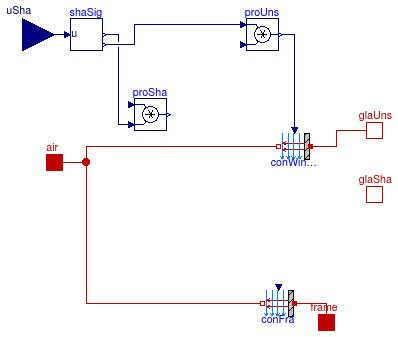
Partial model for boundary conditions for convection and radiation for a window surface with or without shade, that is outside or inside the room.
This allows using the model as a base class for windows with inside shade, outside shade, or no shade.
| Type | Name | Default | Description |
|---|---|---|---|
| Area | A | Heat transfer area of frame and window [m2] | |
| Real | fFra | Fraction of window frame divided by total window area | |
| Shading | |||
| Boolean | haveExteriorShade | Set to true if window has exterior shade (at surface a) | |
| Boolean | haveInteriorShade | Set to true if window has interior shade (at surface b) | |
| Boolean | thisSideHasShade | Set to true if this side of the model has a shade | |
| Type | Name | Description |
|---|---|---|
| input RealInput | uSha | Input connector, used to scale the surface area to take into account an operable shading device, 0: unshaded; 1: fully shaded |
| HeatPort_a | air | Port that connects to the air (room or outside) |
| HeatPort_b | glaUns | Heat port that connects to unshaded part of glass |
| HeatPort_b | glaSha | Heat port that connects to shaded part of glass |
| HeatPort_a | frame | Heat port at window frame |
partial model PartialWindowBoundaryCondition
"Partial model for heat convection or radiation between a possibly shaded window that can be outside or inside the room"
parameter Modelica.SIunits.Area A "Heat transfer area of frame and window";
parameter Real fFra "Fraction of window frame divided by total window area";
final parameter Modelica.SIunits.Area AFra = fFra * A "Frame area";
final parameter Modelica.SIunits.Area AGla = A-AFra "Glass area";
parameter Boolean haveExteriorShade
"Set to true if window has exterior shade (at surface a)";
parameter Boolean haveInteriorShade
"Set to true if window has interior shade (at surface b)";
final parameter Boolean haveShade = haveExteriorShade or haveInteriorShade
"Set to true if window system has a shade";
parameter Boolean thisSideHasShade
"Set to true if this side of the model has a shade";
Modelica.Blocks.Interfaces.RealInput uSha if haveShade
"Input connector, used to scale the surface area to take into account an operable shading device, 0: unshaded; 1: fully shaded";
Modelica.Thermal.HeatTransfer.Interfaces.HeatPort_a air
"Port that connects to the air (room or outside)";
Modelica.Thermal.HeatTransfer.Interfaces.HeatPort_b glaUns
"Heat port that connects to unshaded part of glass";
Modelica.Thermal.HeatTransfer.Interfaces.HeatPort_b glaSha if haveShade
"Heat port that connects to shaded part of glass";
Modelica.Thermal.HeatTransfer.Components.Convection conWinUns
"Convection from unshaded part of window to outside or room air";
Modelica.Thermal.HeatTransfer.Interfaces.HeatPort_a frame
"Heat port at window frame";
Modelica.Thermal.HeatTransfer.Components.Convection conFra
"Convective heat transfer between air and frame";
protected
Modelica.Blocks.Math.Product proUns "Product for unshaded part of window";
Modelica.Blocks.Math.Product proSha if haveShade
"Product for shaded part of window";
ShadingSignal shaSig(final haveShade=haveShade)
"Conversion for shading signal";
initial equation
assert(( thisSideHasShade and haveShade) or (not thisSideHasShade),
"Parameters \"thisSideHasShade\" and \"haveShade\" are not consistent. Check parameters");
equation
connect(conWinUns.fluid, air);
connect(conFra.fluid, air);
connect(conFra.solid, frame);
connect(glaUns, conWinUns.solid);
connect(proUns.y, conWinUns.Gc);
connect(uSha, shaSig.u);
connect(proSha.u2, shaSig.y);
connect(shaSig.yCom, proUns.u1);
end PartialWindowBoundaryCondition;
 Buildings.HeatTransfer.Windows.BaseClasses.PartialRadiation
Buildings.HeatTransfer.Windows.BaseClasses.PartialRadiation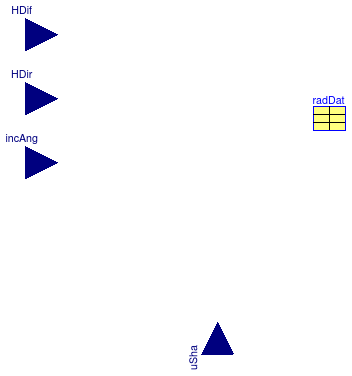
| Type | Name | Default | Description |
|---|---|---|---|
| Boolean | haveExteriorShade | Set to true if window has an exterior shade | |
| Boolean | haveInteriorShade | Set to true if window has an interior shade | |
| Area | AWin | Area of window [m2] | |
| Glass | |||
| Integer | N | Number of glass layers | |
| Length | xGla[N] | Thickness of glass [m] | |
| TransmissionCoefficient | tauGlaSol[N] | Solar transmissivity of glass [1] | |
| ReflectionCoefficient | rhoGlaSol_a[N] | Solar reflectivity of glass at surface a (facing outside) [1] | |
| ReflectionCoefficient | rhoGlaSol_b[N] | Solar reflectivity of glass at surface b (facing room-side) [1] | |
| Shade | |||
| TransmissionCoefficient | tauShaSol_a | Solar transmissivity of shade for irradiation from air-side [1] | |
| TransmissionCoefficient | tauShaSol_b | Solar transmissivity of shade for irradiation from glass-side [1] | |
| ReflectionCoefficient | rhoShaSol_a | Solar reflectivity of shade for irradiation from air-side [1] | |
| ReflectionCoefficient | rhoShaSol_b | Solar reflectivity of shade for irradiation from glass-side [1] | |
| Type | Name | Description |
|---|---|---|
| input RealInput | uSha | Control signal for shading (0: unshaded; 1: fully shaded) |
| input RealInput | HDif | Diffussive solar radiation [W/m2] |
| input RealInput | incAng | Incident angle [rad] |
| input RealInput | HDir | Direct solar radiation [W/m2] |
partial block PartialRadiation
"Partial model for variables and data used in radiation calculation"
extends Modelica.Blocks.Interfaces.BlockIcon;
extends Buildings.HeatTransfer.Windows.BaseClasses.RadiationBaseData;
////////////////// Parameters that are not used by RadiationData
parameter Boolean haveExteriorShade
"Set to true if window has an exterior shade";
parameter Boolean haveInteriorShade
"Set to true if window has an interior shade";
parameter Modelica.SIunits.Area AWin "Area of window";
////////////////// Derived parameters
final parameter Boolean haveShade=haveExteriorShade or haveInteriorShade
"Set to true if window has a shade";
final parameter Buildings.HeatTransfer.Windows.BaseClasses.RadiationData
radDat(
final N=N,
final tauGlaSol=tauGlaSol,
final rhoGlaSol_a=rhoGlaSol_a,
final rhoGlaSol_b=rhoGlaSol_b,
final xGla=xGla,
final tauShaSol_a=tauShaSol_a,
final tauShaSol_b=tauShaSol_b,
final rhoShaSol_a=rhoShaSol_a,
final rhoShaSol_b=rhoShaSol_b)
"Optical properties of window for different irradiation angles";
Modelica.Blocks.Interfaces.RealInput uSha(min=0, max=1) if haveShade
"Control signal for shading (0: unshaded; 1: fully shaded)";
Modelica.Blocks.Interfaces.RealInput HDif(quantity="RadiantEnergyFluenceRate",
unit="W/m2") "Diffussive solar radiation";
Modelica.Blocks.Interfaces.RealInput incAng(
final quantity="Angle",
final unit="rad",
displayUnit="deg") "Incident angle";
Modelica.Blocks.Interfaces.RealInput HDir(quantity="RadiantEnergyFluenceRate",
unit="W/m2") "Direct solar radiation";
protected
Modelica.Blocks.Interfaces.RealInput uSha_internal(min=0, max=1)
"Control signal for shading (0: unshaded; 1: fully shaded)";
initial equation
/* Current model assumes that the window only has either an interior or exterior shade.
Warn user if it has an interior and exterior shade.
Allowing both shades at the same time would require rewriting part of the model. */
assert(not (haveExteriorShade and haveInteriorShade),
"Window radiation model does not support an exterior and interior shade at the same time.");
equation
// Connect statement for conditionally removed connector uSha
connect(uSha, uSha_internal);
if (not haveShade) then
uSha_internal = 0;
end if;
end PartialRadiation;
 Buildings.HeatTransfer.Windows.BaseClasses.PartialShade_weatherBus
Buildings.HeatTransfer.Windows.BaseClasses.PartialShade_weatherBus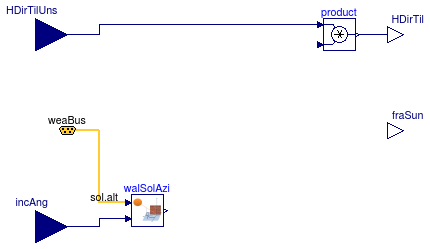
Partial model to implement overhang and side fin model with weather bus as a connector.
Extends from Buildings.HeatTransfer.Windows.BaseClasses.ShadeInterface_weatherBus (Base class for models of window shade and overhangs).
| Type | Name | Default | Description |
|---|---|---|---|
| Window | |||
| Length | hWin | Window height [m] | |
| Length | wWin | Window width [m] | |
| Type | Name | Description |
|---|---|---|
| Bus | weaBus | Weather data bus |
| input RealInput | incAng | Solar incidence angle [rad] |
| input RealInput | HDirTilUns | Direct solar irradiation on tilted, unshaded surface [W/m2] |
| output RealOutput | HDirTil | Direct solar irradiation on tilted, shaded surface [W/m2] |
| output RealOutput | fraSun | Fraction of the area that is unshaded [1] |
partial model PartialShade_weatherBus "Partial model to implement overhang and side fins with weather bus connector" extends Buildings.HeatTransfer.Windows.BaseClasses.ShadeInterface_weatherBus; // Window dimensions parameter Modelica.SIunits.Length hWin "Window height"; parameter Modelica.SIunits.Length wWin "Window width";protected Buildings.BoundaryConditions.SolarGeometry.BaseClasses.WallSolarAzimuth walSolAzi "Wall solar azimuth"; Modelica.Blocks.Math.Product product; equationconnect(weaBus.sol.alt, walSolAzi.alt); connect(walSolAzi.incAng, incAng); connect(product.y, HDirTil); connect(product.u1, HDirTilUns); end PartialShade_weatherBus;
 Buildings.HeatTransfer.Windows.BaseClasses.TransmittedRadiation
Buildings.HeatTransfer.Windows.BaseClasses.TransmittedRadiation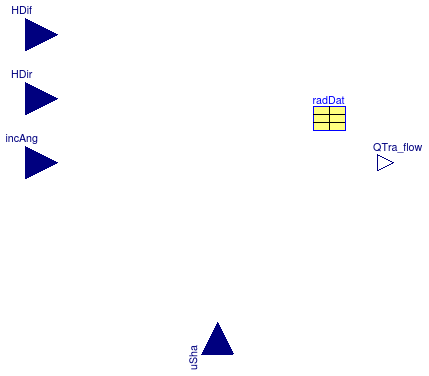
AWin*(1-uSha)*HDif*tau(HEM)
AWin*(1-uSha)*HDir*tau(IncAng)
AWin*uSha*HDif*tauSha(HEM)
AWin*uSha*HDir*tauSha(IncAng);
QTra_flow = Part1 + Part2 + Part3 + Part4
| Type | Name | Default | Description |
|---|---|---|---|
| Boolean | haveExteriorShade | Set to true if window has an exterior shade | |
| Boolean | haveInteriorShade | Set to true if window has an interior shade | |
| Area | AWin | Area of window [m2] | |
| Glass | |||
| Integer | N | Number of glass layers | |
| Length | xGla[N] | Thickness of glass [m] | |
| TransmissionCoefficient | tauGlaSol[N] | Solar transmissivity of glass [1] | |
| ReflectionCoefficient | rhoGlaSol_a[N] | Solar reflectivity of glass at surface a (facing outside) [1] | |
| ReflectionCoefficient | rhoGlaSol_b[N] | Solar reflectivity of glass at surface b (facing room-side) [1] | |
| Shade | |||
| TransmissionCoefficient | tauShaSol_a | Solar transmissivity of shade for irradiation from air-side [1] | |
| TransmissionCoefficient | tauShaSol_b | Solar transmissivity of shade for irradiation from glass-side [1] | |
| ReflectionCoefficient | rhoShaSol_a | Solar reflectivity of shade for irradiation from air-side [1] | |
| ReflectionCoefficient | rhoShaSol_b | Solar reflectivity of shade for irradiation from glass-side [1] | |
| Type | Name | Description |
|---|---|---|
| input RealInput | uSha | Control signal for shading (0: unshaded; 1: fully shaded) |
| input RealInput | HDif | Diffussive solar radiation [W/m2] |
| input RealInput | incAng | Incident angle [rad] |
| input RealInput | HDir | Direct solar radiation [W/m2] |
| output RealOutput | QTra_flow | Transmitted exterior radiation through the window. (1: no shade; 2: shade) [W] |
block TransmittedRadiation "Transmitted radiation through window" extends Buildings.HeatTransfer.Windows.BaseClasses.PartialRadiation;Modelica.Blocks.Interfaces.RealOutput QTra_flow(final quantity="Power", final unit="W") "Transmitted exterior radiation through the window. (1: no shade; 2: shade)"; final parameter Real traCoeRoo(fixed=false) "Transmitivity of the window glass for interior radiation without shading"; output Modelica.SIunits.Power QTraUns_flow "Transmitted solar radiation through unshaded part of window"; output Modelica.SIunits.Power QTraSha_flow "Transmitted solar radiation through shaded part of window"; protected Integer k=1; Real x; final parameter Integer NDIR=radDat.NDIR; final parameter Integer HEM=radDat.HEM; constant Integer NoShade=1; constant Integer Shade=2; constant Integer Interior=1; constant Integer Exterior=2; final parameter Real coeTraWinExtIrr[2, radDat.HEM + 2](fixed=false); Real tmpNoSha; Real tmpSha; Real incAng2; initial algorithm //************************************************************** // Assign coefficients. // Data dimension from Orginal ([1 : HEM]) to New ([2 : HEM+1]) // with 2 dummy variable for interpolation. //************************************************************** // Glass for j in 1:HEM loop // Properties for glass without shading coeTraWinExtIrr[NoShade, j + 1] := radDat.traRef[1, 1, N, j]; // Properties for glass with shading if haveInteriorShade then coeTraWinExtIrr[Shade, j + 1] := radDat.winTraExtIrrIntSha[j]; elseif haveExteriorShade then coeTraWinExtIrr[Shade, j + 1] := radDat.winTraExtIrrExtSha[j]; else // No Shade coeTraWinExtIrr[Shade, j + 1] := 0.0; end if; end for; // Dummy variables at 1 and HEM+2 for k in NoShade:Shade loop coeTraWinExtIrr[k, 1] := coeTraWinExtIrr[k, 2]; coeTraWinExtIrr[k, HEM + 2] := coeTraWinExtIrr[k, HEM + 1]; end for; //************************************************************** // Glass: transmissivity for interior irradiation //************************************************************** traCoeRoo := radDat.traRef[1, N, 1, HEM]; algorithm QTraUns_flow := AWin*HDif*(1 - uSha_internal)*coeTraWinExtIrr[NoShade, HEM + 1]; QTraSha_flow := AWin*HDif*uSha_internal*coeTraWinExtIrr[Shade, HEM + 1]; //************************************************************** // Glass, Device: add absorbed radiation (angular part) from exterior sources //************************************************************** // Use min() instead of if() to avoid event incAng2 := min(incAng, 0.5*Modelica.Constants.pi); x := 2*(NDIR - 1)*abs(incAng2)/Modelica.Constants.pi "x=(index-1)*incAng/(0.5pi), 0<=x<=NDIR-1"; x := x + 2; // Window unshaded parts: add transmitted radiation for angular radiation tmpNoSha := Buildings.HeatTransfer.Windows.BaseClasses.smoothInterpolation({ coeTraWinExtIrr[NoShade, k] for k in 1:(HEM + 2)}, x); QTraUns_flow := QTraUns_flow + AWin*HDir*(1 - uSha_internal)*tmpNoSha; // Window shaded parts: add transmitted radiation for angular radiation tmpSha := Buildings.HeatTransfer.Windows.BaseClasses.smoothInterpolation( {coeTraWinExtIrr[Shade, k] for k in 1:(HEM + 2)}, x); QTraSha_flow := QTraSha_flow + AWin*HDir*uSha_internal*tmpSha; // Assign quantities to output connectors QTra_flow := QTraUns_flow + QTraSha_flow;end TransmittedRadiation;
 Buildings.HeatTransfer.Windows.BaseClasses.WindowRadiation
Buildings.HeatTransfer.Windows.BaseClasses.WindowRadiation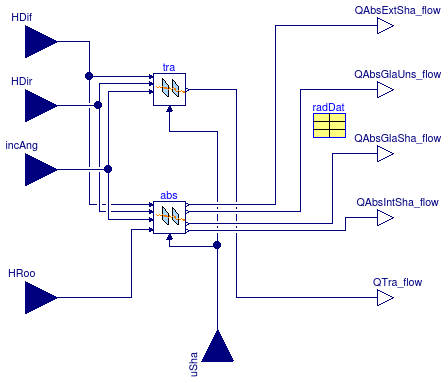
The model calculates solar radiation through the window. The calculations follow the description in Wetter (2004), Appendix A.4.3.
The absorbed radiation by exterior shades includes:
AWin*uSha*(HDir+HDif)*(1-tau-rho)
AWin*uSha*HDir*tau*rho(IncAng)*(1-tau-rho)
AWin*uSha*HDif*tau*rho(HEM)*(1-tau-rho)
The output is absRad[2, 1]
The absorbed radiation by interior shades includes:
AWin*uSha*HDir*alpha(IncAng)
AWin*uSha*HDif*alpha(HEM)
AWin*uSha*HRoo*(1-tau-rho)
The output is absRad[2, N+2]
The absorbed radiation by glass includes:
AWin*(1-uSha)*(HDif*alphaEx(HEM)+HRoo*alphaIn(HEM))
AWin*(1-uSha)*HDir*alphaEx(IncAng)
AWin*uSha*(HDif*alphaExSha(HEM)+HRoo*alphaInSha(HEM))
AWin*uSha*HDir*alphaExSha(IncAng)
The output is absRad[1, 2:N+1] = Part1 + Part2; absRad[2, 2:N+1] = Part3 + Part4
The transmitted exterior radiation for window system includes:
AWin*(1-uSha)*HDif*tau(HEM)
AWin*(1-uSha)*HDir*tau(IncAng)
AWin*uSha*HDif*tauSha(HEM)
AWin*uSha*HDir*tauSha(IncAng);
The output is QTra_flow = Part1 + Part2 + Part3 + Part4
| Type | Name | Default | Description |
|---|---|---|---|
| Boolean | haveExteriorShade | Set to true if window has an exterior shade | |
| Boolean | haveInteriorShade | Set to true if window has an interior shade | |
| Area | AWin | Area of window [m2] | |
| Glass | |||
| Integer | N | Number of glass layers | |
| Length | xGla[N] | Thickness of glass [m] | |
| TransmissionCoefficient | tauGlaSol[N] | Solar transmissivity of glass [1] | |
| ReflectionCoefficient | rhoGlaSol_a[N] | Solar reflectivity of glass at surface a (facing outside) [1] | |
| ReflectionCoefficient | rhoGlaSol_b[N] | Solar reflectivity of glass at surface b (facing room-side) [1] | |
| Shade | |||
| TransmissionCoefficient | tauShaSol_a | Solar transmissivity of shade for irradiation from air-side [1] | |
| TransmissionCoefficient | tauShaSol_b | Solar transmissivity of shade for irradiation from glass-side [1] | |
| ReflectionCoefficient | rhoShaSol_a | Solar reflectivity of shade for irradiation from air-side [1] | |
| ReflectionCoefficient | rhoShaSol_b | Solar reflectivity of shade for irradiation from glass-side [1] | |
| Type | Name | Description |
|---|---|---|
| input RealInput | uSha | Control signal for shading (0: unshaded; 1: fully shaded) |
| input RealInput | HDif | Diffussive solar radiation [W/m2] |
| input RealInput | incAng | Incident angle [rad] |
| input RealInput | HDir | Direct solar radiation [W/m2] |
| input RealInput | HRoo | Diffussive radiation from room [W/m2] |
| output RealOutput | QTra_flow | Transmitted exterior radiation through the window. (1: no shade; 2: shade) [W] |
| output RealOutput | QAbsExtSha_flow | Absorbed interior and exterior radiation by exterior shading device [W] |
| output RealOutput | QAbsIntSha_flow | Absorbed interior and exterior radiation by interior shading device [W] |
| output RealOutput | QAbsGlaUns_flow[N] | Absorbed interior and exterior radiation by unshaded part of glass [W] |
| output RealOutput | QAbsGlaSha_flow[N] | Absorbed interior and exterior radiation by shaded part of glass [W] |
block WindowRadiation "Calculation radiation for window" extends Buildings.HeatTransfer.Windows.BaseClasses.PartialRadiation;Modelica.Blocks.Interfaces.RealInput HRoo(quantity="RadiantEnergyFluenceRate", unit="W/m2") "Diffussive radiation from room "; Modelica.Blocks.Interfaces.RealOutput QTra_flow(final quantity="Power", final unit="W") "Transmitted exterior radiation through the window. (1: no shade; 2: shade)"; Modelica.Blocks.Interfaces.RealOutput QAbsExtSha_flow(final quantity="Power", final unit="W") "Absorbed interior and exterior radiation by exterior shading device"; Modelica.Blocks.Interfaces.RealOutput QAbsIntSha_flow(final quantity="Power", final unit="W") "Absorbed interior and exterior radiation by interior shading device"; Modelica.Blocks.Interfaces.RealOutput QAbsGlaUns_flow[N](each quantity= "Power", each final unit="W") "Absorbed interior and exterior radiation by unshaded part of glass"; Modelica.Blocks.Interfaces.RealOutput QAbsGlaSha_flow[N](each quantity= "Power", each final unit="W") "Absorbed interior and exterior radiation by shaded part of glass"; Buildings.HeatTransfer.Windows.BaseClasses.TransmittedRadiation tra( final N=N, final tauGlaSol=tauGlaSol, final rhoGlaSol_a=rhoGlaSol_a, final rhoGlaSol_b=rhoGlaSol_b, final xGla=xGla, final tauShaSol_a=tauShaSol_a, final rhoShaSol_a=rhoShaSol_a, final rhoShaSol_b=rhoShaSol_b, final haveExteriorShade=haveExteriorShade, final haveInteriorShade=haveInteriorShade, final AWin=AWin, final tauShaSol_b=tauShaSol_b); Buildings.HeatTransfer.Windows.BaseClasses.AbsorbedRadiation abs( final N=N, final tauGlaSol=tauGlaSol, final rhoGlaSol_a=rhoGlaSol_a, final rhoGlaSol_b=rhoGlaSol_b, final xGla=xGla, final tauShaSol_a=tauShaSol_a, final tauShaSol_b=tauShaSol_b, final rhoShaSol_a=rhoShaSol_a, final rhoShaSol_b=rhoShaSol_b, final haveExteriorShade=haveExteriorShade, final haveInteriorShade=haveInteriorShade, final AWin=AWin); protected final parameter Boolean noShade=not (haveExteriorShade or haveInteriorShade) "Flag, true if the window has a shade"; equation if noShade then assert(uSha_internal < 1E-6, "Window has no shade, but control signal is non-zero.\n" + " Received uSha_internal = " + String(uSha_internal)); end if;connect(HDif, tra.HDif); connect(HDif, abs.HDif); connect(HDir, tra.HDir); connect(HDir, abs.HDir); connect(incAng, tra.incAng); connect(incAng, abs.incAng); connect(HRoo, abs.HRoo); connect(tra.uSha, uSha); connect(abs.uSha, uSha); connect(tra.QTra_flow, QTra_flow); connect(abs.QAbsIntSha_flow, QAbsIntSha_flow); connect(abs.QAbsGlaSha_flow, QAbsGlaSha_flow); connect(abs.QAbsGlaUns_flow, QAbsGlaUns_flow); connect(abs.QAbsExtSha_flow, QAbsExtSha_flow); end WindowRadiation;
| Type | Name | Default | Description |
|---|---|---|---|
| Glass | |||
| Integer | N | Number of glass layers | |
| Length | xGla[N] | Thickness of glass [m] | |
| TransmissionCoefficient | tauGlaSol[N] | Solar transmissivity of glass [1] | |
| ReflectionCoefficient | rhoGlaSol_a[N] | Solar reflectivity of glass at surface a (facing outside) [1] | |
| ReflectionCoefficient | rhoGlaSol_b[N] | Solar reflectivity of glass at surface b (facing room-side) [1] | |
| Shade | |||
| TransmissionCoefficient | tauShaSol_a | Solar transmissivity of shade for irradiation from air-side [1] | |
| TransmissionCoefficient | tauShaSol_b | Solar transmissivity of shade for irradiation from glass-side [1] | |
| ReflectionCoefficient | rhoShaSol_a | Solar reflectivity of shade for irradiation from air-side [1] | |
| ReflectionCoefficient | rhoShaSol_b | Solar reflectivity of shade for irradiation from glass-side [1] | |
partial record RadiationBaseData
"Basic parameters for window radiation calculation"
parameter Integer N(min=1) "Number of glass layers";
parameter Modelica.SIunits.Length xGla[N] "Thickness of glass";
parameter Modelica.SIunits.TransmissionCoefficient tauGlaSol[N]
"Solar transmissivity of glass";
parameter Modelica.SIunits.ReflectionCoefficient rhoGlaSol_a[N]
"Solar reflectivity of glass at surface a (facing outside)";
parameter Modelica.SIunits.ReflectionCoefficient rhoGlaSol_b[N]
"Solar reflectivity of glass at surface b (facing room-side)";
parameter Modelica.SIunits.TransmissionCoefficient tauShaSol_a
"Solar transmissivity of shade for irradiation from air-side";
parameter Modelica.SIunits.TransmissionCoefficient tauShaSol_b
"Solar transmissivity of shade for irradiation from glass-side";
parameter Modelica.SIunits.ReflectionCoefficient rhoShaSol_a
"Solar reflectivity of shade for irradiation from air-side";
parameter Modelica.SIunits.ReflectionCoefficient rhoShaSol_b
"Solar reflectivity of shade for irradiation from glass-side";
end RadiationBaseData;
 Buildings.HeatTransfer.Windows.BaseClasses.RadiationData
Buildings.HeatTransfer.Windows.BaseClasses.RadiationData
| Type | Name | Default | Description |
|---|---|---|---|
| Glass | |||
| Integer | N | Number of glass layers | |
| Length | xGla[N] | Thickness of glass [m] | |
| TransmissionCoefficient | tauGlaSol[N] | Solar transmissivity of glass [1] | |
| ReflectionCoefficient | rhoGlaSol_a[N] | Solar reflectivity of glass at surface a (facing outside) [1] | |
| ReflectionCoefficient | rhoGlaSol_b[N] | Solar reflectivity of glass at surface b (facing room-side) [1] | |
| Shade | |||
| TransmissionCoefficient | tauShaSol_a | Solar transmissivity of shade for irradiation from air-side [1] | |
| TransmissionCoefficient | tauShaSol_b | Solar transmissivity of shade for irradiation from glass-side [1] | |
| ReflectionCoefficient | rhoShaSol_a | Solar reflectivity of shade for irradiation from air-side [1] | |
| ReflectionCoefficient | rhoShaSol_b | Solar reflectivity of shade for irradiation from glass-side [1] | |
record RadiationData "Radiation data of a window"
extends Modelica.Icons.Record;
extends Buildings.HeatTransfer.Windows.BaseClasses.RadiationBaseData;
final parameter Real glass[3, N]={tauGlaSol,rhoGlaSol_a,rhoGlaSol_b}
"Glass solar transmissivity, solar reflectivity at surface a and b, at normal incident angle";
final parameter Real traRefShaDev[2, 2]={{tauShaSol_a,tauShaSol_b},{
rhoShaSol_a,rhoShaSol_b}} "Shading device property";
final parameter Integer NDIR=10 "Number of incident angles";
final parameter Integer HEM=NDIR + 1 "Index of hemispherical integration";
final parameter Modelica.SIunits.Angle psi[NDIR]=
Buildings.HeatTransfer.Windows.Functions.getAngle(NDIR)
"Incident angles used for solar radiation calculation";
final parameter Real layer[3, N, HEM]=
Buildings.HeatTransfer.Windows.Functions.glassProperty(
N,
HEM,
glass,
xGla,
psi) "Angular and hemispherical transmissivity, front (outside-facing) and back (room facing) reflectivity
of each glass pane";
final parameter Real traRef[3, N, N, HEM]=
Buildings.HeatTransfer.Windows.Functions.getGlassTR(
N,
HEM,
layer) "Angular and hemispherical transmissivity, front (outside-facing) and back (room facing) reflectivity
between glass panes for exterior or interior irradiation without shading";
final parameter Real absExtIrrNoSha[N, HEM]=
Buildings.HeatTransfer.Windows.Functions.glassAbsExteriorIrradiationNoShading(
traRef,
N,
HEM) "Angular and hemispherical absorptivity of each glass pane
for exterior irradiation without shading";
final parameter Real absIntIrrNoSha[N]=
Buildings.HeatTransfer.Windows.Functions.glassAbsInteriorIrradiationNoShading(
traRef,
N,
HEM) "Hemispherical absorptivity of each glass pane
for interior irradiation without shading";
final parameter Real winTraExtIrrExtSha[HEM]=
Buildings.HeatTransfer.Windows.Functions.winTExteriorIrradiatrionExteriorShading(
traRef,
traRefShaDev,
N,
HEM) "Angular and hemispherical transmissivity of a window system (glass + exterior shading device)
for exterior irradiation";
final parameter Real absExtIrrExtSha[N, HEM]=
Buildings.HeatTransfer.Windows.Functions.glassAbsExteriorIrradiationExteriorShading(
absExtIrrNoSha,
traRef,
traRefShaDev,
N,
HEM) "Angular and hemispherical absorptivity of each glass pane
for exterior irradiation with exterior shading";
final parameter Real winTraExtIrrIntSha[HEM]=
Buildings.HeatTransfer.Windows.Functions.winTExteriorIrradiationInteriorShading(
traRef,
traRefShaDev,
N,
HEM) "Angular and hemispherical transmissivity of a window system (glass and interior shading device)
for exterior irradiation";
final parameter Real absExtIrrIntSha[N, HEM]=
Buildings.HeatTransfer.Windows.Functions.glassAbsExteriorIrradiationInteriorShading(
absExtIrrNoSha,
traRef,
traRefShaDev,
N,
HEM) "Angular and hemispherical absorptivity of each glass layer
for exterior irradiation with interior shading";
final parameter Real devAbsExtIrrIntShaDev[HEM]=
Buildings.HeatTransfer.Windows.Functions.devAbsExteriorIrradiationInteriorShading(
traRef,
traRefShaDev,
N,
HEM) "Angular and hemispherical absorptivity of an interior shading device
for exterior irradiation";
final parameter Real winTraRefIntIrrExtSha[3]=
Buildings.HeatTransfer.Windows.Functions.winTRInteriorIrradiationExteriorShading(
traRef,
traRefShaDev,
N,
HEM) "Hemisperical transmissivity and reflectivity of a window system (glass and exterior shadig device)
for interior irradiation. traRefIntIrrExtSha[1]: transmissivity,
traRefIntIrrExtSha[2]: Back reflectivity; traRefIntIrrExtSha[3]: dummy value";
final parameter Real absIntIrrExtSha[N]=
Buildings.HeatTransfer.Windows.Functions.glassAbsInteriorIrradiationExteriorShading(
absIntIrrNoSha,
traRef,
traRefShaDev,
N,
HEM) "Hemispherical absorptivity of each glass pane
for interior irradiation with exterior shading";
final parameter Real absIntIrrIntSha[N]=
Buildings.HeatTransfer.Windows.Functions.glassAbsInteriorIrradiationInteriorShading(
absIntIrrNoSha,
traRef,
traRefShaDev,
N,
HEM) "Hemispherical absorptivity of each glass pane
for interior irradiation with interior shading";
final parameter Real winTraRefIntIrrIntSha[3]=
Buildings.HeatTransfer.Windows.Functions.winTRInteriorIrradiationInteriorShading(
traRef,
traRefShaDev,
N,
HEM) "Hemisperical transmissivity and back reflectivity of a window system (glass and interior shadig device)
for interior irradiation";
final parameter Real devAbsIntIrrIntSha=
Buildings.HeatTransfer.Windows.Functions.devAbsInteriorIrradiationInteriorShading(
traRef,
traRefShaDev,
N,
HEM)
"Hemiperical absorptivity of an interior shading device for interior irradiation";
end RadiationData;
Function for convective heat transfer in vertical window cavity. The computation is according to TARCOG 2006, except that this implementation computes the convection coefficient as a function that is differentiable in the temperatures.
TARCOG 2006: Carli, Inc., TARCOG: Mathematical models for calculation of thermal performance of glazing systems with our without shading devices, Technical Report, Oct. 17, 2006.
| Type | Name | Default | Description |
|---|---|---|---|
| Generic | gas | Thermophysical properties of gas fill | |
| Real | Ra | Rayleigh number | |
| Temperature | T_m | Temperature used for thermophysical properties [K] | |
| TemperatureDifference | dT | Temperature difference used to compute q_flow = h*dT [K] | |
| Area | h | 1.5 | Height of window [m2] |
| Real | deltaNu | 0.1 | Small value for Nusselt number, used for smoothing |
| Real | deltaRa | 1E3 | Small value for Rayleigh number, used for smoothing |
| Type | Name | Description |
|---|---|---|
| Real | Nu | Nusselt number |
| CoefficientOfHeatTransfer | hCon | Convective heat transfer coefficient [W/(m2.K)] |
| HeatFlux | q_flow | Convective heat flux [W/m2] |
function convectionVerticalCavity
"Free convection in vertical cavity"
input Buildings.HeatTransfer.Data.Gases.Generic gas
"Thermophysical properties of gas fill";
input Real Ra(min=0) "Rayleigh number";
input Modelica.SIunits.Temperature T_m
"Temperature used for thermophysical properties";
input Modelica.SIunits.TemperatureDifference dT
"Temperature difference used to compute q_flow = h*dT";
input Modelica.SIunits.Area h(min=0) = 1.5 "Height of window";
input Real deltaNu(min=0.01) = 0.1
"Small value for Nusselt number, used for smoothing";
input Real deltaRa(min=0.01) = 1E3
"Small value for Rayleigh number, used for smoothing";
output Real Nu(min=0) "Nusselt number";
output Modelica.SIunits.CoefficientOfHeatTransfer hCon(min=0)
"Convective heat transfer coefficient";
output Modelica.SIunits.HeatFlux q_flow "Convective heat flux";
protected
Real Nu_1(min=0) "Nusselt number";
Real Nu_2(min=0) "Nusselt number";
algorithm
Nu_1 :=Buildings.Utilities.Math.Functions.spliceFunction(
pos=0.0673838*Ra^(1/3),
neg=Buildings.Utilities.Math.Functions.spliceFunction(
pos=0.028154*Ra^(0.4134),
neg=1 + 1.7596678E-10*Ra^(2.2984755),
x=Ra - 1E4,
deltax=deltaRa),
x=Ra - 5E4,
deltax=deltaRa);
/*
if ( Ra <= 1E4) then
Nu_1 = 1 + 1.7596678E-10*Ra^(2.2984755);
elseif ( Ra <= 5E4) then
Nu_1 = 0.028154*Ra^(0.4134);
else
Nu_1 = 0.0673838*Ra^(1/3);
end if;
*/
Nu_2 :=0.242*(Ra/(h/gas.x))^(0.272);
Nu :=Buildings.Utilities.Math.Functions.smoothMax(
x1=Nu_1,
x2=Nu_2,
deltaX=deltaNu);
hCon :=Nu*Buildings.HeatTransfer.Data.Gases.thermalConductivity(gas, T_m)/gas.x;
q_flow :=hCon*dT;
end convectionVerticalCavity;
Function for convective heat transfer in horizontal window cavity. The computation is according to TARCOG 2006, except that this implementation computes the convection coefficient as a function that is differentiable in the temperatures.
TARCOG 2006: Carli, Inc., TARCOG: Mathematical models for calculation of thermal performance of glazing systems with our without shading devices, Technical Report, Oct. 17, 2006.
| Type | Name | Default | Description |
|---|---|---|---|
| Generic | gas | Thermophysical properties of gas fill | |
| Real | Ra | Rayleigh number | |
| Temperature | T_m | Temperature used for thermophysical properties [K] | |
| TemperatureDifference | dT | Temperature difference used to compute q_flow = h*dT [K] | |
| Angle | til | Window tilt [rad] | |
| Real | sinTil | Sine of window tilt | |
| Real | cosTil | Cosine of the window tilt | |
| Area | h | 1.5 | Height of window [m2] |
| Real | deltaNu | 0.1 | Small value for Nusselt number, used for smoothing |
| Real | deltaRa | 1E3 | Small value for Rayleigh number, used for smoothing |
| Type | Name | Description |
|---|---|---|
| Real | Nu | Nusselt number |
| CoefficientOfHeatTransfer | hCon | Convective heat transfer coefficient [W/(m2.K)] |
| HeatFlux | q_flow | Convective heat flux [W/m2] |
function convectionHorizontalCavity
"Free convection in horizontal cavity"
input Buildings.HeatTransfer.Data.Gases.Generic gas
"Thermophysical properties of gas fill";
input Real Ra(min=0) "Rayleigh number";
input Modelica.SIunits.Temperature T_m
"Temperature used for thermophysical properties";
input Modelica.SIunits.TemperatureDifference dT
"Temperature difference used to compute q_flow = h*dT";
input Modelica.SIunits.Angle til "Window tilt";
input Real sinTil "Sine of window tilt";
input Real cosTil "Cosine of the window tilt";
input Modelica.SIunits.Area h(min=0) = 1.5 "Height of window";
input Real deltaNu(min=0.01) = 0.1
"Small value for Nusselt number, used for smoothing";
input Real deltaRa(min=0.01) = 1E3
"Small value for Rayleigh number, used for smoothing";
output Real Nu(min=0) "Nusselt number";
output Modelica.SIunits.CoefficientOfHeatTransfer hCon(min=0)
"Convective heat transfer coefficient";
output Modelica.SIunits.HeatFlux q_flow "Convective heat flux";
protected
Real Nu_1(min=0) "Nusselt number";
Real Nu_2(min=0) "Nusselt number";
constant Real dx=0.1 "Half-width of interval used for smoothing";
algorithm
if cosTil > 0 then
Nu :=Buildings.Utilities.Math.Functions.spliceFunction(
pos=
Buildings.HeatTransfer.Windows.BaseClasses.nusseltHorizontalCavityReduced(
gas=gas,
Ra=Ra,
T_m=T_m,
dT=dT,
h=h,
sinTil=sinTil,
deltaNu=deltaNu,
deltaRa=deltaRa),
neg=
Buildings.HeatTransfer.Windows.BaseClasses.nusseltHorizontalCavityEnhanced(
gas=gas,
Ra=Ra,
T_m=T_m,
dT=dT,
til=til,
cosTil=abs(cosTil)),
x=dT+dx,
deltax=dx);
else
Nu :=Buildings.Utilities.Math.Functions.spliceFunction(
pos=
Buildings.HeatTransfer.Windows.BaseClasses.nusseltHorizontalCavityEnhanced(
gas=gas,
Ra=Ra,
T_m=T_m,
dT=dT,
til=til,
cosTil=abs(cosTil)),
neg=
Buildings.HeatTransfer.Windows.BaseClasses.nusseltHorizontalCavityReduced(
gas=gas,
Ra=Ra,
T_m=T_m,
dT=dT,
h=h,
sinTil=sinTil,
deltaNu=deltaNu,
deltaRa=deltaRa),
x=dT-dx,
deltax=dx);
end if;
hCon :=Nu*Buildings.HeatTransfer.Data.Gases.thermalConductivity(gas, T_m)/gas.x;
q_flow :=hCon*dT;
end convectionHorizontalCavity;
Function for Nusselt number in horizontal window cavity. The computation is according to TARCOG 2006, except that this implementation computes the Nusselt number as a function that is differentiable in the temperatures.
TARCOG 2006: Carli, Inc., TARCOG: Mathematical models for calculation of thermal performance of glazing systems with our without shading devices, Technical Report, Oct. 17, 2006.
| Type | Name | Default | Description |
|---|---|---|---|
| Generic | gas | Thermophysical properties of gas fill | |
| Real | Ra | Rayleigh number | |
| Temperature | T_m | Temperature used for thermophysical properties [K] | |
| TemperatureDifference | dT | Temperature difference used to compute q_flow = h*dT [K] | |
| Angle | til | Window tilt [rad] | |
| Real | cosTil | Cosine of the window tilt |
| Type | Name | Description |
|---|---|---|
| Real | Nu | Nusselt number |
function nusseltHorizontalCavityEnhanced
"Nusselt number for horizontal cavity, bottom surface warmer than top surface"
input Buildings.HeatTransfer.Data.Gases.Generic gas
"Thermophysical properties of gas fill";
input Real Ra(min=0) "Rayleigh number";
input Modelica.SIunits.Temperature T_m
"Temperature used for thermophysical properties";
input Modelica.SIunits.TemperatureDifference dT
"Temperature difference used to compute q_flow = h*dT";
input Modelica.SIunits.Angle til "Window tilt";
input Real cosTil(min=0) "Cosine of the window tilt";
output Real Nu(min=0) "Nusselt number";
protected
Real k1 "Auxiliary variable";
Real k2 "Auxiliary variable";
Real k11 "Auxiliary variable";
Real k22 "Auxiliary variable";
algorithm
// Windows inclined from 0 to 60 deg (eqn. 3.1-42 to 3.1-43)
k1 :=1 - 1708/Ra/cosTil;
k2 :=(Ra*cosTil/5830)^(1/3) - 1;
k11 :=(k1 + Buildings.Utilities.Math.Functions.smoothMax(
x1=k1,
x2=-k1,
deltaX=1E-1))/2;
k22 :=(k2 + Buildings.Utilities.Math.Functions.smoothMax(
x1=k2,
x2=-k2,
deltaX=1E-1))/2;
Nu :=1 + 1.44*k11*(1 - 1708*abs(Modelica.Math.sin(1.8*til*180/Modelica.Constants.pi))
^(1.6)/Ra/cosTil) + k22;
end nusseltHorizontalCavityEnhanced;
Function for Nusselt number in horizontal window cavity. The computation is according to TARCOG 2006, except that this implementation computes the Nusselt number as a function that is differentiable in the temperatures.
TARCOG 2006: Carli, Inc., TARCOG: Mathematical models for calculation of thermal performance of glazing systems with our without shading devices, Technical Report, Oct. 17, 2006.
| Type | Name | Default | Description |
|---|---|---|---|
| Generic | gas | Thermophysical properties of gas fill | |
| Real | Ra | Rayleigh number | |
| Temperature | T_m | Temperature used for thermophysical properties [K] | |
| TemperatureDifference | dT | Temperature difference used to compute q_flow = h*dT [K] | |
| Area | h | 1.5 | Height of window [m2] |
| Real | sinTil | Sine of window tilt | |
| Real | deltaNu | 0.1 | Small value for Nusselt number, used for smoothing |
| Real | deltaRa | 1E3 | Small value for Rayleigh number, used for smoothing |
| Type | Name | Description |
|---|---|---|
| Real | Nu | Nusselt number |
function nusseltHorizontalCavityReduced
"Nusselt number for horizontal cavity, bottom surface colder than top surface"
input Buildings.HeatTransfer.Data.Gases.Generic gas
"Thermophysical properties of gas fill";
input Real Ra(min=0) "Rayleigh number";
input Modelica.SIunits.Temperature T_m
"Temperature used for thermophysical properties";
input Modelica.SIunits.TemperatureDifference dT
"Temperature difference used to compute q_flow = h*dT";
input Modelica.SIunits.Area h(min=0) = 1.5 "Height of window";
input Real sinTil "Sine of window tilt";
input Real deltaNu(min=0.01) = 0.1
"Small value for Nusselt number, used for smoothing";
input Real deltaRa(min=0.01) = 1E3
"Small value for Rayleigh number, used for smoothing";
output Real Nu(min=0) "Nusselt number";
protected
Real NuVer(min=0) "Nusselt number for vertical window";
algorithm
NuVer :=Buildings.HeatTransfer.Windows.BaseClasses.convectionVerticalCavity(
gas=gas,
Ra=Ra,
T_m=T_m,
dT=dT,
h=h,
deltaNu=deltaNu,
deltaRa=deltaRa);
Nu :=1 + (NuVer - 1)*sinTil;
end nusseltHorizontalCavityReduced;
Function to interpolate within a data array without triggerring events.
| Type | Name | Default | Description |
|---|---|---|---|
| Real | y[:] | Data array | |
| Real | x | x value |
| Type | Name | Description |
|---|---|---|
| Real | val | Return value |
function smoothInterpolation
"Get interpolated data without triggering events"
input Real y[:] "Data array";
input Real x "x value";
output Real val "Return value";
protected
Integer k1;
Integer k2;
Real y1d;
Real y2d;
algorithm
k1 := integer(x);
k2 := k1 + 1;
y1d := (y[k1 + 1] - y[k1 - 1])/2;
y2d := (y[k2 + 1] - y[k2 - 1])/2;
val := Modelica.Fluid.Utilities.cubicHermite(
x,
k1,
k2,
y[k1],
y[k2],
y1d,
y2d);
end smoothInterpolation;